Phantasmagoria
Part One: Primitive
Accumulation
Chapter Three
Enlightenment in the
South Pacific
1.
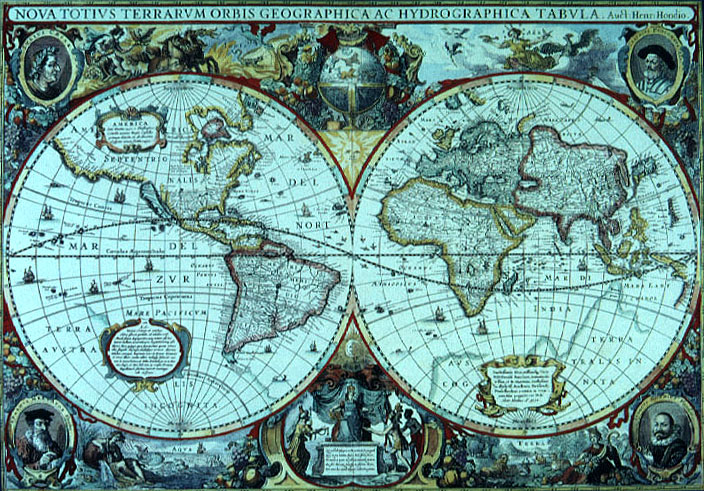 European expansion into
Africa and the Americas in the sixteenth century lies at the origins of global
capitalism. It also constitutes a radical break between the mediaeval and modern
periods. Before that break, the ruling classes of Europe acted in a world in
which their will to power was constrained by Islamic empires to be sure, but
also by the rudimentary state of navigation and cartography, and by a consequent
ignorance of global geography. After the break, they took their place at the
dominant center of an accumulation process that was destined to revolutionize
existing social conditions, both in Europe and beyond. An important aspect of such
revolutionary transformation was the elevation of science to an increasingly
significant position in maritime exploration, material production, and
intellectual life.
European expansion into
Africa and the Americas in the sixteenth century lies at the origins of global
capitalism. It also constitutes a radical break between the mediaeval and modern
periods. Before that break, the ruling classes of Europe acted in a world in
which their will to power was constrained by Islamic empires to be sure, but
also by the rudimentary state of navigation and cartography, and by a consequent
ignorance of global geography. After the break, they took their place at the
dominant center of an accumulation process that was destined to revolutionize
existing social conditions, both in Europe and beyond. An important aspect of such
revolutionary transformation was the elevation of science to an increasingly
significant position in maritime exploration, material production, and
intellectual life.
To begin with, certain scientific advances made the great voyages of
discovery possible. As early as the fifteenth century, Renaissance polymaths
developed methods for projecting the three dimensional surface of the globe onto
the two dimensional matrix of a map. These geometrical procedures were soon
given practical significance by the use of astronomical tables, the quadrant,
and the mariner's astrolabe to determine position with some degree of
mathematical exactness. Together scientific astronomy, cartography, and
navigation enabled Europeans to investigate all regions of the earth and record
information about its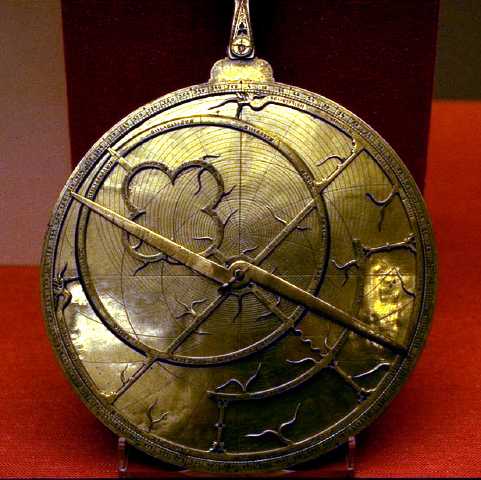 lands and waterways in such a fashion that long
distance voyages could be undertaken and, even more importantly, repeated. This
methodical and precise information was a necessary condition of organizing the
exchange of commodities, and the extraction of economic surpluses, on a
planetary scale. Once the capitalist world market was in place, it acted as a
further incentive to scientific progress. Especially in the core countries,
consumer wants multiplied along with the means of satisfying them through
expanding circuits of commodity production and exchange. In response to the
growing demand for goods of all kinds, the wealthy began to reinvest their
profits in innovative industries and agricultural enterprises. These in turn
required the creation of a host of new natural sciences and stimulated the
development of already existing ones.
lands and waterways in such a fashion that long
distance voyages could be undertaken and, even more importantly, repeated. This
methodical and precise information was a necessary condition of organizing the
exchange of commodities, and the extraction of economic surpluses, on a
planetary scale. Once the capitalist world market was in place, it acted as a
further incentive to scientific progress. Especially in the core countries,
consumer wants multiplied along with the means of satisfying them through
expanding circuits of commodity production and exchange. In response to the
growing demand for goods of all kinds, the wealthy began to reinvest their
profits in innovative industries and agricultural enterprises. These in turn
required the creation of a host of new natural sciences and stimulated the
development of already existing ones.
At first, the ruling classes of Europe and their priests and other
ideological functionaries were not able to grasp the epochal significance of
this situation. As we have seen, they interpreted the new world system with
ideas drawn from a Catholic culture that was deeply rooted in the Middle Ages.
But it was only a relatively short period of time before the centrality of
science to global capitalism began to register in intellectual affairs. Writing
in the early seventeenth century, Francis Bacon was perhaps the first thinker to
recognize the revolutionary implications of the new sciences for the
organization of knowledge and the guidance of practical activity, in short, for
the whole conduct of life. According to his celebrated formulation, disciplined
empirical inquiry and controlled experiment are capable of making humankind “the
masters and possessors of nature.” In learning to subordinate ourselves to
nature's laws, we discover how to subjugate her all the more completely. We are
compensated for the initial blow to our narcissism by the consequent extension
of our technological power. But we will realize this potential to intervene
cunningly in the nexus of causes and effects only if we relinquish prevailing
habits of scholastic speculation and theological reverie. For Bacon, the human
mind hopelessly embroils itself in fantasy in the attempt to penetrate to the
hidden essence of things. The culture of old Europe is more or less the outcome
of that vain attempt. The most sophisticated forms of mediaeval thinking make
use of so many Platonic and Aristotelian “idols of the theatre,” representations
of the world in a scenic and unreal fashion. Such empty metaphysical imaginings
act as a fetter on the development of useful knowledge of empirical causes and
therefore on the many sided satisfaction of human needs. In the name of science
and its promise of genuine prosperity, The New Organon and Bacon's other
writings issue a sort of declaration of war against the past.
That declaration was renewed in the mid-eighteenth century by the
scientists, philosophers, and secular literati who occupied the forward cultural
outposts known as the Enlightenment. Significant Enlightenment thinking went on
in Switzerland, Italy, Germany, and the United States. But it is not an accident
that the real home of that audacious movement was jointly located in Great
Britain and France, for these were the powers currently engaged in a struggle
for world 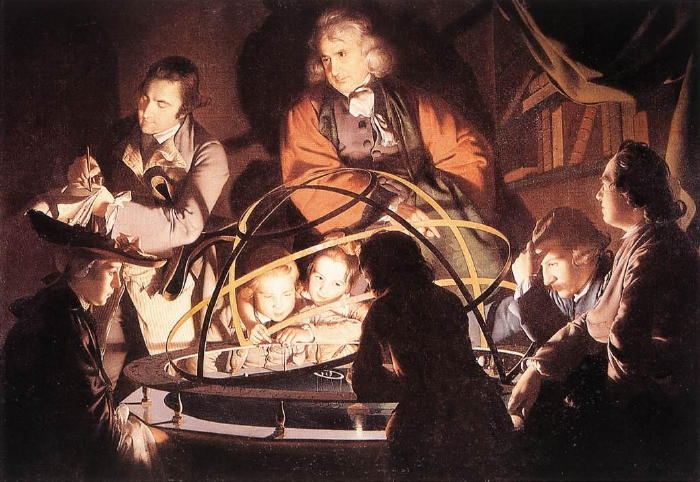 hegemony. The pretensions of Spain and Portugal to global
rule had collapsed in the early seventeenth century with the end of primitive
accumulation itself, that is to say, with the definitive consolidation of
capitalism as a self-sustaining mode of production and exchange. The rivalry
between the initial contestants gave way to a hundred year period of Dutch
domination. But that was only an interregnum. By the early eighteenth century,
the aspirations of the Low Countries had already been eclipsed by the ascendancy
of France and England, which now directed their national ambitions against one
another, sometimes in open warfare. Most of the Enlightenment thinkers of the
two contending powers were cosmopolitans, not nationalists. And many of them
argued vociferously against militarist adventures. But the wide public influence
they and their comrades enjoyed was not due to such pacific arguments. Rather,
it was a result of the fact that they offered broad and persuasive programs of
economic, political, and cultural reform to nations that saw themselves, quite
plausibly, as occupying the dynamic center of the planet. They promised to
replace the dogmatic anachronisms of Catholic Europe with sober insights into
the real forces capable of shaping a brave new world.
hegemony. The pretensions of Spain and Portugal to global
rule had collapsed in the early seventeenth century with the end of primitive
accumulation itself, that is to say, with the definitive consolidation of
capitalism as a self-sustaining mode of production and exchange. The rivalry
between the initial contestants gave way to a hundred year period of Dutch
domination. But that was only an interregnum. By the early eighteenth century,
the aspirations of the Low Countries had already been eclipsed by the ascendancy
of France and England, which now directed their national ambitions against one
another, sometimes in open warfare. Most of the Enlightenment thinkers of the
two contending powers were cosmopolitans, not nationalists. And many of them
argued vociferously against militarist adventures. But the wide public influence
they and their comrades enjoyed was not due to such pacific arguments. Rather,
it was a result of the fact that they offered broad and persuasive programs of
economic, political, and cultural reform to nations that saw themselves, quite
plausibly, as occupying the dynamic center of the planet. They promised to
replace the dogmatic anachronisms of Catholic Europe with sober insights into
the real forces capable of shaping a brave new world.
Enlightenment interest in the peoples encountered by Europeans in the
voyages of discovery was pervasive. But strange to say for a movement that drew
its major inspiration from the sciences, that interest was not itself scientific
in character, at least not in the sense of contributing to one of the empirical
sciences. Although Hume, Voltaire, Diderot, and Rousseau, among others, devoted
sometimes considerable space in their writings to indigenous peoples, none of
them did so from even a rudimentary anthropological point of view. None of them
attempted to classify indigenous societies in terms of their tools and other
technologies, collect their myths, observe and record their rituals, or explore
the subtleties of their kinship systems. Instead the Enlightenment thinkers who
wrote about “savages” did so from the vantage point of moral and political
engagement in their own countries. Their aim was not to understand indigenous
peoples with any meaningful specificity, but to employ a general concept of “the
savage” in order to subject dominant European institutions and practices to
rational evaluation and reform. For them native peoples were not objects of
serious ethnography; they were instruments of social critique.
2.
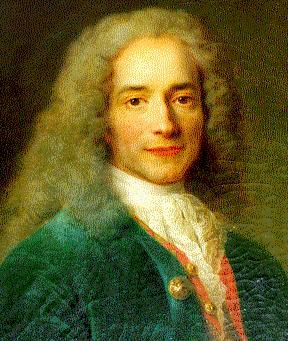
In 1756, Voltaire published L'Ingenu, the fictional story of the
son of a French army officer who is raised from infancy in Canada by Huron
Indians, and journeys by accident in his young adulthood to his ancestral home
in Lower Breton. The story is unusual in that it is a hybrid between two
literary genres. It is half comic satire on the prejudices, self-deceptions, and
abuses of power of Parisian as well as provincial high society; and it is half
what the Germans will later call a Bildungsroman, in which the hero loses
his original innocence through a painful process of theoretical and moral
education. Voltaire dubs the story's protagonist, the “Child of Nature,” but the
name is not meant to indicate a pre-social condition. In recounting some of the
details of his past life, the hero expresses affection for the Huron nurse who
raised him, pain at the death of his mistress who was eaten by a bear, mercy for
an Algonquin warrior he defeated in battle, and attachment to Huron laws and
customs, the unmistakable creations of an ordered society. But in native Canada,
the social order is not the product of coercive or artificial arrangements. It
is the unfettered expression of three impulses that are almost biological in
character and that are, as it were, the voice of nature speaking directly within
each human being: a love of freedom, especially freedom from physical
confinement, an uncomplicated sexual ardor, and a willingness to speak one's
mind without dissimulation. The adoptive Huron continues to follow these
impulses in the country of his European forbearers. Only there they contrast
glaringly with the groveling servility to superiors, the sexual hypocrisy, and
the general social duplicity of the French upper classes.
In Voltaire's story, then, the distinction between the Child of Nature
and the cultivated European at first works to the disadvantage of the latter. In
the light cast by the ingenu’s direct and vigorous approach to life, the
civilized manners of the French aristocracy show themselves to be no more than
masks hiding a profound inner corruption. But Voltaire is far from recommending
emulation of native Canada as an answer to the problems of modern Europe. When
the Child of Nature is imprisoned in Paris by scheming Jesuits for expressing
sympathy with a Huguenot heretic, he does not hesitate to take the opportunity
to shed his rude and unformed character. He uses the enforced solitude to study
philosophy, mathematics, the Greek tragedies, and the plays of Moliere and
Racine. His only advantage in this endeavor over the ordinary French citizen is
that his past has left him untainted by envy, theological obscurantism, and the
lure of power. Since he has none of the faults of a Europe that has lost its
way, he is able to return to the very sources of culture, and so acquire it from
an unsullied starting point:
The rapid development of his mind was almost
as much due to his savage upbringing as to the spirit he was endowed with, for
having been taught nothing during his childhood, he had not acquired any
prejudices. Since his understanding had not been warped by error, it had
retained its original rectitude. He saw things as they are, whereas the ideas we
have been given in childhood compel us to see them in false lights all our
lives.
He becomes a deist, an advocate of religious tolerance, a promoter of
scientific thinking, and a rational critic of society ─ in other words, an
Enlightenment intellectual. Moreover, after the intervention of his lover
secures his release from prison and results in her own tragic death, the Child
of Nature receives a commission as an army officer and becomes a celebrated
personality in Paris.
In 1754, two years before the publication of L’Ingenu, Rousseau
submitted the manuscript of his Discourse on the Origins of Inequality to
the Academy of Dijon as an entry in an essay competition (which he failed to
win). When he sent Voltaire a copy of the treatise, the latter wrote in
response:
I have received, Monsieur, your new book
against the human race, and I thank you. No one has employed so much
intelligence to turn us men into beasts. One starts wanting to walk on all fours
after reading your book. However, in more than sixty years I have lost the
habit.
The jibe is perfectly understandable. The discussion of
savages in the Discourse has implications far more radical than
Voltaire's handling of the topic in L’Ingenu. In the first place,
Rousseau's critique of private property and of the political intrigues of the
rich against the poor, both of which mark the transition from the state of
nature to civil society, offended the older philosophe's eminently
bourgeois sensibilities.
In the second place, Rousseau's uncompromising rejection of the city as a
locus of envy, duplicity, and moral enervation could hardly please Voltaire. For
Rousseau, the life of a Parisian celebrity, even one steeped in Enlightenment
culture, was a regression, not an advance, from the savage state. And yet the
basic theoretical move of the Discourse is similar to the literary ploy
at the heart of L’Ingenu. Like Voltaire, its author appeals to the life
of savages as a natural condition that reveals contemporary Europe to be the
product of decadence or corruption.
Rousseau is aware that his treatise is not a contribution to empirical
science. He recognizes that, in 1754, the field research and other “experiments”
necessary to create the foundations of a genuine science of society have not yet
been conducted. But he also insists that there is no way to understand
Europe's contemporary
predicament without separating “that which is original from that which is
artificial in man's present nature.”
This pressing need justifies the purely hypothetical method of reasoning adopted
in the Discourse. The purpose of that method is to define the character
of “natural man,” to create an image of the human species as it exists in the
state of nature, to construct a model of the original human condition. It may be
the case that nothing in prehistory corresponds exactly to that model. But even
if this were true, it would not rob the model of its heuristic significance. It
is possible to distinguish the natural from the artificial even without ordering
the two in terms of temporal succession. All that is necessary is that one basic
principle be kept in mind. The theorist must be careful not to project back into
the state of nature qualities that human beings develop from their participation
in civil society, with its antagonistic economic and political institutions and
tortuous psychological states. According to Rousseau, this was Hobbes' error.
The “war of each against all” is no more natural to the species than honor or
private property, which are, in fact, the real bones of contention in that war.
If we suspend in thought the existence of civil society and its effects on human
behavior, then it becomes apparent that people are motivated by two impulses
only: straightforward concern with one's own preservation and pity for the
suffering of other sentient beings.
Rousseau imagines the species obeying these impulses in an environment
unaltered by technology and with social bonds that extend no further than the
act of sexual intercourse and the tie between mother and prepubescent child. By
means of this thought experiment, he hypothetically reconstructs the state of
nature as the earliest stage in human prehistory. It is a stage in which people
are certainly not very intelligent ─ they have no language, no culture, no
abstract thought ─ but in which they are supremely happy. Abandoned to the
forces of external nature, those who survive childhood are physically robust,
and their size, strength, and speed enable them to protect themselves against
predators. In the lush forests that they inhabit, their simple needs for food
and rest are satisfied with a minimal degree of effort. Since no one requires
anything of anyone else beyond momentary sexual release, each goes his or her
own way without obstruction. This means that the original human beings have no
fear of one another. For the same reason, they are unfamiliar with vanity (a
concern for one's image in the eyes of others) and the fury of offended honor
that is one of vanity's more destructive expressions. Most importantly, they
live without any thought of the future and therefore entirely without
anxiety.
The reports of missionaries, colonialists, merchants, and
travelers concerning the customs and habits of indigenous peoples play a
complicated role in this reconstruction. Rousseau appeals to some of these
accounts to support elements of his hypothesis. For example, an anecdote about a
Carib Indian who sells his bed in the morning and regrets the sale in the
evening, having failed to foresee that he would need the bed to sleep in at
night, is supposed to lend credence to the idea that, in their earliest
prehistory, human beings dwelled only in the immediate sensation of their
present existence. Still, Rousseau is clear that contemporary savages do not
live in the state of nature. They have languages, family structures, and
rudimentary technologies. But they are closer to the original condition than is
European society. In fact, they occupy a half way point “between the indolence
of the primitive state and the petulant activity of our own
amour-propre.” The development of private property and the antagonistic
selfhood that has its origins in amour-propre (selfish pride) leads
further and further away from that balanced condition which is “the true youth
of the world.” The progress that Europeans value so highly consists in “so many
steps in appearance towards the improvement of the individual, but so many steps
in reality towards the decrepitude of the species.
Yet, even here, Rousseau is not as far from Voltaire as the
irritated comments of the latter might lead us to believe, for he also does not
counsel Europeans to adopt a savage way of life. His point rather is that the
“natural man” continues to exist beneath the artificial layers accumulated in
the course of a life in a decadent society. Since even the most profound
corruptions do not alter that primordial substratum of humanity, Europeans,
should they so desire, have the power to begin the process of education and
political organization all over again.
The burden of Emile and The Social Contract is to show how these
two tasks might be accomplished.
The theoretical role played by the savage condition in the context of one
Enlightenment project, then, is to serve as a pristine starting point for the
creation of a new European culture. But the culture of savages themselves is
irrelevant to that project. In particular, neither L’Ingenu nor the
Discourse discusses the spiritual beliefs and practices of indigenous
peoples or the artifacts and other objects in which those beliefs and practices
achieve material concretion. That discussion was left to an author who was by no
means as sympathetic to the life of savages as Voltaire and Rousseau.
3.
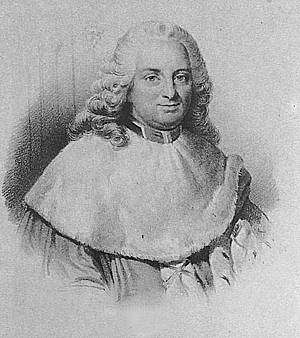 In 1757, Charles de Brosses submitted the preliminary results of his
inquiry into the religiously significant material culture of indigenous peoples
to the Academie des Inscriptions et Belles-Lettres, of which he was a
member. At that point, Diderot became aware of the manuscript and suggested that
de Brosses communicate with Hume, whose Natural History of Religion had been
published earlier the same year. Brosses followed Diderot's suggestion, and
initiated a correspondence with the British philosopher, whose book and private
communications came to have a profound impact on his subsequent work. Under
Hume's influence, Brosses completed a treatise based on the material previously
submitted to the Academy and titled it, On the Cult of Divine Fetishes or the
Parallel between the Ancient Religion of Egypt and the Contemporary Religion of
the Negroes. Fearing persecution at the hands of the authorities, he
published the book in France in 1760 clandestinely, that is, through a third
party and without the author's name.
In 1757, Charles de Brosses submitted the preliminary results of his
inquiry into the religiously significant material culture of indigenous peoples
to the Academie des Inscriptions et Belles-Lettres, of which he was a
member. At that point, Diderot became aware of the manuscript and suggested that
de Brosses communicate with Hume, whose Natural History of Religion had been
published earlier the same year. Brosses followed Diderot's suggestion, and
initiated a correspondence with the British philosopher, whose book and private
communications came to have a profound impact on his subsequent work. Under
Hume's influence, Brosses completed a treatise based on the material previously
submitted to the Academy and titled it, On the Cult of Divine Fetishes or the
Parallel between the Ancient Religion of Egypt and the Contemporary Religion of
the Negroes. Fearing persecution at the hands of the authorities, he
published the book in France in 1760 clandestinely, that is, through a third
party and without the author's name.
His fear, no doubt, was justified. Helvetius had been persecuted two
years earlier for his atheistic treatise, Concerning the Spirit. And,
while de Brosses was not an atheist, his book had uncomfortable implications for
the Roman Catholicism that was still the dominant ideological power in France.
It would have been hard for the eighteenth-century reader to have missed the
fact that holy images, relics of the saints, and even the Eucharist, in which
Christ is supposed to be actually present, resemble the African and Amerindian
sacred objects that serve as the main topic of de Brosses' work. Writing in
Anglican England, Hume had already made the relevance of the discussion of
“primitive” religion to the critique of Roman Catholicism crystal clear: the
Natural History of Religion unambiguously associates Catholic beliefs and
practices with those of the earliest idolaters and polytheists. Hume's
correspondence with de Brosses alone would have been enough to have condemned
the investigations of the latter in the eyes of the French
Church.
But there was more for French Catholics to worry about than this guilt by
association. The two thinkers were in substantive agreement concerning their
basic theories of religion. Like Hume, de Brosses was a deist. Both men believed
that the only rational version of religious belief is based on the so-called
argument from design. While this is implicit, though unmistakably so, in
Brosses' book, Hume states the position overtly in the Natural History of
Religion. According to his introductory remarks, nature is a vast machine
whose intricate parts are so marvelously interconnected that the whole must be
the product of an intelligent artisan, a maker who designed the machine and set
it in motion without needing to interfere any further in its workings. But,
unfortunately, the force of this argument can be appreciated only by those who
have some grasp of the true grandeur and sophistication of the universal nexus
of causes and effects. The earliest human communities, as well as the uneducated
masses of later times, lacked that understanding, and yet had definite ideas
concerning the nature of divine power. It follows that, at its origin and
throughout most of its history, religious belief has been irrational. In a
reversal of the formal schema that guided Voltaire and Rousseau, Hume argues
that the primitive, in the sense of the original, human condition is
unequivocally inferior to the modern one, at least insofar as modernity is
represented by the enlightened segment of the population. Progress is a
straightforward transition from the less to the more reasonable. In a passage
that Brosses repeats verbatim in On the Cult of Divine Fetishes, though
without identifying its source, Hume writes:
It seems certain, that, according to the
natural progress of human thought, the ignorant multitude must first entertain
some groveling and familiar notion of superior powers, before they stretch their
conception to that perfect being, who bestowed order on the whole frame of
nature. We may as reasonably imagine, that men inhabited palaces before huts and
cottages, or studied geometry before agriculture; as assert that the deity
appeared to them as pure spirit, omniscient, omnipotent, and omnipresent, before
he was apprehended to be a powerful, tho' limited being, with human passions,
appetites, limbs and organs. The mind rises gradually from inferior to
superior…
If the origin of religion is not to be found in reason,
where then does it lie? In answer to this question, Hume appeals to certain
basic psychological mechanisms. The objects of our deepest hopes and fears ─
plenty and want, health and sickness, life and death ─ are the effects of
unknown causes. If we could analyze nature from the vantage point of “the most
probable, at least the most intelligible, philosophy,” we would see that these
causes lie in complex material interactions between human bodies and external
objects, interactions that are governed by “constant and regular machinery.” But
such a perspective is not available to the ignorant multitude, and certainly not
to that “barbarous, necessitous animal (such as man is on the first origin of
society).
According to Hume, the earliest human beings could not help but evolve confused
ideas of the causes upon which their fate was so utterly dependent. Since the
purpose of the ideas was to make the unfamiliar familiar, primitive peoples
imagined the unknown sources of their happiness and misery as possessing the
qualities with which they were most intimately acquainted: those of conscious
personality.
Hume mentions contemporary indigenous peoples only once in his treatise,
and then merely to affirm that: “The savage tribes of America, Africa, and Asia are all
idolaters.
Most of his examples are drawn from Greek, Roman, Pagan European, and Catholic
sources. When it comes to the psychological complex ─ ignorance, anxiety,
anthropomorphic projection ─ at the root of irrational religion, these cultures
are also representative of the original human
condition.
The grand parallel that de Brosses draws between the religion
of the contemporary Africans and that of the ancient Egyptians, with references
to Greek, Roman, Pagan European, and Old Testament themes, demonstrates that he
shares this conception with Hume. For him as well, primitive religion is not the
exclusive domain of contemporary savages, but a cultural complex found wherever
reason has not yet triumphed. Nevertheless, the focus of his book is on
indigenous peoples, since, according to him, they exhibit the most complete
absence of rational thought. They have no more capacity for conceptual
reflection than “a four year old child.
Lacking any knowledge of the true relationship between causes and effects, they
live in constant fear of the forces in their environment, and in the equally
blind hope that those forces will operate in such a fashion as to produce
beneficial results. In accordance with the compensatory psychological mechanism
that Hume analyzed, they see spirits everywhere. But Hume was a bit misleading
when he said that savages are idolaters. Most of them do not exhibit the
idolatry that we associate with the classical world, for example: that of
deified human beings. According to de Brosses, native peoples are usually given to
more base superstitions. “Their knowledge is limited like that of beasts to the
natural needs of life.” They project their gods into the objects that most concern
them: plants and animals, features of the landscape, and inanimate things. These
they endow with consciousness and will, like the European child who plays with
dolls, believing them to have a life of their own. However, unlike the child,
they regard these objects as superior powers that control the forces of human
destiny, and so they exhibit the most pitiful attitudes of terror, rapturous
enthusiasm, and servile adoration with respect to them.
Following the Portuguese in western and central
Africa, de Brosses calls these objects, fetiches. His treatment,
though, misses the derivation of the word from the Latin, facticius,
“made by human hands,” and instead asserts a false etymology from the Latin
root, fatum, fanum, fari, referring to divine,
enchanted, or fairy-like objects.
The reason for this error is obvious: de Brosses's belief in the stupidity of
savages does not allow him to pay proper attention to products of human skill,
since skill, after all, is a form of knowledge, and indeed knowledge of causal
connections. In one passage he does refer to “an ugly little idol made of clay”
from the Guinea
coast, an evident result, however imperfect, of manual production. But, in
general, his emphasis is on what we might follow the surrealists in calling
“found objects.” The fetish is:
… nothing other than the first material object
chosen by each particular nation or person and consecrated by its priests in
ceremonies: it can be a tree, a mountain, a piece of wood, a lion's tale, a
pebble, a shell, salt, a fish, a plant, a flower, an animal of a certain species
such as a cow, goat, elephant, sheep; anything imaginable.
For Brosses, the fetish has no aesthetic significance since is not an
artifact, or at best an extremely crude one. Although his book describes the
material culture in which indigenous peoples express their deepest ideas about
the nature of reality, it is not, from its own point of view, a treatise about
indigenous art. It is, rather, a thesis in the history of religion, and one that
at least attempts a certain degree of empirical verification. Brosses coins the
word fetichisme for the cult in which crude artifacts and found objects
alike are employed for ritual and magical purposes. In attempting to demonstrate
that fetishism is common to the entire indigenous world, he makes a more
comprehensive use of the information available on native societies than any
other Enlightenment thinker. He draws from a wide range of reports from Africa
and the Americas, and, in the process, touches on a number of topics that were
to receive sustained attention by nineteenth and twentieth century
anthropologists, including totemic animals, possession cults, and the concept of
the Manitou. Yet the principal significance of his work does not lie in its
empirical detail, or even in its anticipation of later, genuinely scientific
investigations. Rather, de Brosses' major achievement consists in the use that
he makes of an originally Catholic concept for the purposes of enlightened
thought.
We saw in the previous chapter that the Portuguese had developed the
concept of the fetish in an attempt to distinguish the religious artifacts,
especially the minkisi, of native Africa, from those of Roman
Catholicism. But since the concept was part of a culture that affirmed the
participation of the world in Divine Being, and the consequent validity of
relics and images, as receptacles of spiritual power, it was incapable of
performing the discriminating function for which it was intended. De Brosses
resolves this problem by abandoning the attempt to distinguish between fetishes
and genuine sacred objects, for there are no such things. As a deist, he
withdraws God from the world. Since the Divine has no indwelling presence in
material reality, no natural object or artifact, whether indigenous or Roman
Catholic, is capable of serving as a locus of spiritual power.
This theory of fetishism is part of what Max Weber will later call
“disenchantment.” For Brosses, as for the entire Enlightenment, it is a sheer
myth, in other words, a false story, that visible reality is inhabited by
spiritual presences. There is only one reasonable description of the world: that
given by science in terms of impersonal causes and effects. Savages do not see
the truth of this description. But then, they live far from the rationality that
has finally emerged in the European metropole.
4.
For de Brosses, the absence of reason confines savages to a state of nature,
just as it does for Rousseau. For both thinkers, the native is closer to animal
existence than is the civilized person. Only, for Rousseau, this is a positive
judgment. The natural urges toward self-preservation and pity that guide the
actions of savages, just as they do those of animals, result in a happiness that
is no longer available to more "advanced" representatives of the species. For
Brosses, however, the judgment is a negative one. The animal-like stupidity of
Africans and Amerindians prevents them from understanding the true causes of
human fortune and misfortune. Out of fear and blind hope, they project their own
image into the found objects and crude artifacts that are the objects of their
daily concern.
Apart from their divergent evaluative implications, these
two conceptions are united by the rejection of any attempt to understand savages
by means of an appeal to transcendence. The world supplies all of the principles
necessary to explain the behavior of its inhabitants. If it is to produce
genuine knowledge, then empirical and moral inquiry must remain within this
wholly immanent context. It is true that, as a deist, Brosses continues to refer
to the moment of creation. But this is more a way of exiling God from the world
after His first and only act than the perpetuation of a mode of traditional
religious thinking. For deists as well as atheists, there are no miracles, only
the tightly woven fabric of mundane events. Savages are part of that fabric.
When Catholics encountered indigenous peoples in the fifteenth century, they saw
them as actors in a drama of sin and redemption, spiritual stakes in a cosmic
battle between God and the Devil. Enlightenment thinkers rejected this
conception. They viewed savages in relation to natural forces, not divine or
demonic ones.
Their new approach was activated in practice as well as theory when the last
remaining region of the world to be explored by Europeans was fully probed and
mapped in the second half of the eighteenth century.
Appropriately enough, Brosses helped inspire the final voyages of
discovery. In 1756, four years before his treatise on fetishism, he published
The History of Navigation around the Southern
Land
Mass. In that two
volume collection of maps, captains' journals, and his own commentaries, he
renewed the ancient Ptolemaic argument that a great Southern Continent must
exist in order to balance the continents of the north, since otherwise the
planetary sphere would be unstable. Before the History appeared, a
century and a half of voyages had already established the existence of New
Guinea, Australia, New Zealand, New Hebrides, and Tahiti in southern waters,
though these territories proved difficult to exploit and so were never
systematically charted. According to Brosses, a more complete exploration would
reveal them to be the promontories and coastlines of an enormous land mass. He
went on to make the persuasive point that confirmation of the existence of a
Southern Continent and determination of its true dimensions would constitute a
scientific discovery of the highest order. It would represent a contribution to
geography, but also to the study of humankind, since the land mass would
undoubtedly prove to be inhabited by many unique societies. But Brosses also
emphasized the hypothetical continent's extra-scientific value. He argued that
it would be an invaluable resource for French commerce, colonization, and naval
power.
Following the loss of its American colonies to
England in the French and Indian War of 1754 to 1762, the Bourbon monarchy was
anxious to assert its power in another region of the globe. Under the influence
of Brosses' book, in 1766 it dispatched the aristocrat-explorer, Louis de
Bougainville, on a journey around the world in search of the Southern Continent
.
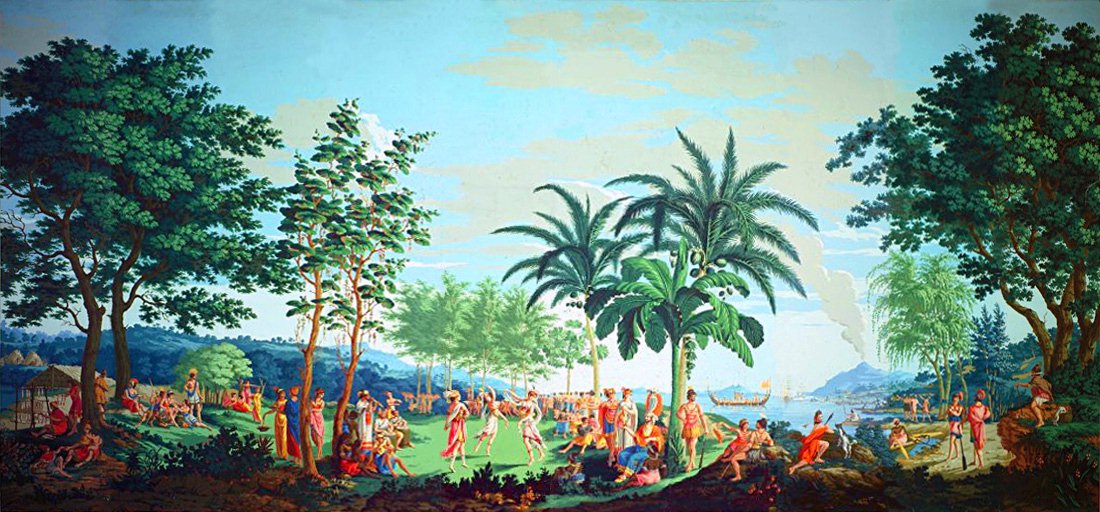
Bourgainville landed by accident in Tahiti nearly two years after
beginning his voyage and stayed a total of thirteen days on the island. In that
short period of time, he created a myth that has proved to have a tenacious hold
on the Western imagination. He named the place, New Cythera, after the
Peloponnesian Island where Venus was said to have been born in the act of
emerging from the sea. In a passage from his journals, Bougainville identified
the reason behind the name. When the sailors on board the two ships he commanded
came ashore, they were
… invited to enter the houses where the people
gave them to eat; nor did the civility of their landlords stop at a slight
collation: they offered them young girls. The hut was immediately filled with a
curious crowd of men and women who made a circle around the guest and the young
victim of hospitality. The ground was spread with leaves and flowers, and their
musicians sang a hymeneal song to the tune of their flutes. Here Venus is
goddess of hospitality, her worship does not admit of any mysteries and every
tribute paid to her is a feast for the whole nation.
The classical allusions were influential. They led later commentators to
depict Polynesian society as an arcadian paradise like the one described in the
Georgics. In addition, they had some influence on the visual arts: many
of the early European paintings of Tahitians and other Polynesians portray their
figures and clothing according to classical conventions. But Bougainville's word
picture of a free and guiltless sexuality had even more important implications
for the way Europeans came to regard the islands of the tropical Pacific. In
particular, Diderot filled in the outlines of the picture in his Supplement
to Bougainville's Voyage, published in 1771.
In his treatment of savages, Diderot contributes to the tradition of
Voltaire and Rousseau. In the Supplement, he writes:
Shall I tell you in brief the history of
almost all our woe? It runs as follows. Once there was a natural man: inside
that man there was installed an artificial man, and within the cave a civil war
began which lasted the whole of his life.
The phrase “our woe” refers, of course, to Europeans. The
Tahitian by contrast carries no artificial man within him. He is not internally
divided, since he has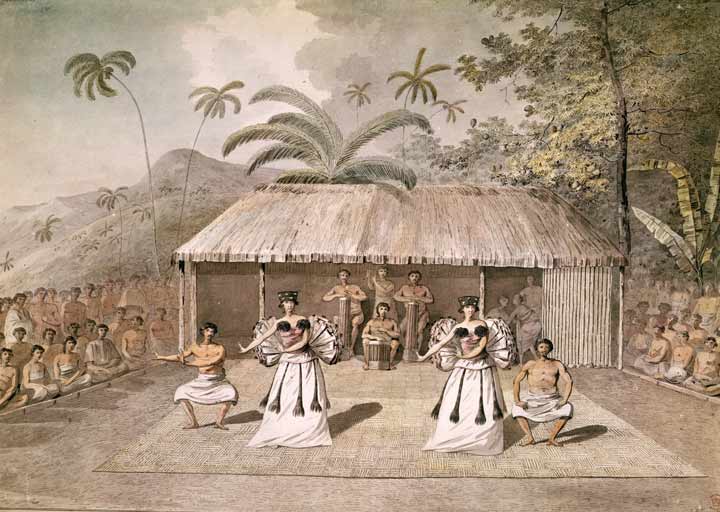 not learned to oppose his
natural instincts, a futile enterprise in any event that can only result in
misery. Most important of all, he freely and openly expresses his need for the
sexual act.
Now Voltaire and Rousseau also affirm the natural sexuality of savages, but that
affirmation does not have the central importance for them that it does for
Diderot. According to the latter, sex is the most significant of the natural
instincts. The history of civilization has made it so. It is the instinct from
which civilized institutions demand the highest degree of repression, and with
the most negative consequences. The incest taboo, the restrictions against
divorce, the cult of female chastity, and the demand for marital fidelity are
different ways of making what ought to be “the greatest, sweetest, most innocent
of pleasures” into “the greatest source of depravity and
evil.” Their attempt to block what continues inexorably to press
toward release converts sexual enjoyment into guilt, envy, jealousy, and
relentless deception.
not learned to oppose his
natural instincts, a futile enterprise in any event that can only result in
misery. Most important of all, he freely and openly expresses his need for the
sexual act.
Now Voltaire and Rousseau also affirm the natural sexuality of savages, but that
affirmation does not have the central importance for them that it does for
Diderot. According to the latter, sex is the most significant of the natural
instincts. The history of civilization has made it so. It is the instinct from
which civilized institutions demand the highest degree of repression, and with
the most negative consequences. The incest taboo, the restrictions against
divorce, the cult of female chastity, and the demand for marital fidelity are
different ways of making what ought to be “the greatest, sweetest, most innocent
of pleasures” into “the greatest source of depravity and
evil.” Their attempt to block what continues inexorably to press
toward release converts sexual enjoyment into guilt, envy, jealousy, and
relentless deception.
Once again, the enemy of the Enlightenment turns out to be Catholicism.
Diderot makes this clear when he places a defense of Tahitian sexuality into the
mouth of the character Orou, who implores a visiting chaplain to sleep with his
wife and daughters. The chaplain's defense of his vow of chastity and of the
other sexual mores of Europe is incapable of withstanding Orou's logic. As his
attempt to defend himself against nature also fails, he ends by complying with
the reasonable requests of his host.
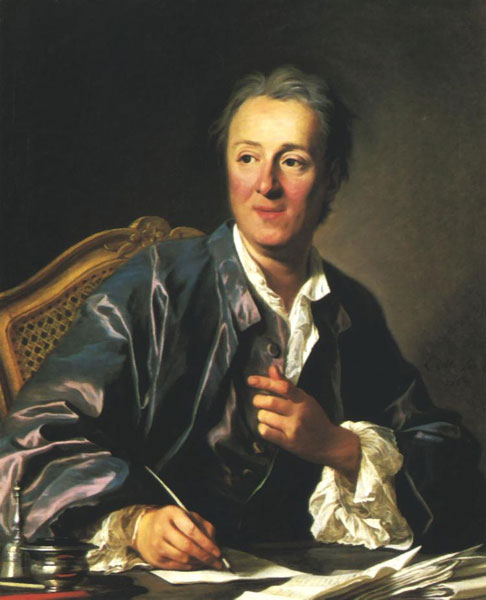 Diderot's decision to focus his account of “natural man” on the issue of
sexuality has an initial plausibility. Is sex not a matter of biological
processes that unfold, as it were, of their own accord, drives that demand
expression no matter what institutions attempt to block them? Here if anywhere
nature seems to prescribe a form of behavior that people oppose at their own
peril. Diderot's view that happiness results from the free expression of sexual
desire and misery from its repression found proponents in such twentieth century
radicals as Alexandra Kollontai, Wilhelm Reich, and Herbert Marcuse. But as
Foucault points out in his critique of such later versions of the discourse of
sexual liberation, the idea of a wholly natural sexuality is absurd. Whatever
role biological drives undoubtedly play in this central area of human
experience, they are always shaped by the institutions and symbolic systems
apart from which life in society is inconceivable. We can extend Foucault's
insight to the Supplement as well. What Diderot misinterprets as the
natural sexuality of Tahitians is simply an alternative expression of sexuality,
every bit as “artificial” as that of Europeans, but differently
configured.
Diderot's decision to focus his account of “natural man” on the issue of
sexuality has an initial plausibility. Is sex not a matter of biological
processes that unfold, as it were, of their own accord, drives that demand
expression no matter what institutions attempt to block them? Here if anywhere
nature seems to prescribe a form of behavior that people oppose at their own
peril. Diderot's view that happiness results from the free expression of sexual
desire and misery from its repression found proponents in such twentieth century
radicals as Alexandra Kollontai, Wilhelm Reich, and Herbert Marcuse. But as
Foucault points out in his critique of such later versions of the discourse of
sexual liberation, the idea of a wholly natural sexuality is absurd. Whatever
role biological drives undoubtedly play in this central area of human
experience, they are always shaped by the institutions and symbolic systems
apart from which life in society is inconceivable. We can extend Foucault's
insight to the Supplement as well. What Diderot misinterprets as the
natural sexuality of Tahitians is simply an alternative expression of sexuality,
every bit as “artificial” as that of Europeans, but differently
configured.
It is easy to show that this is the case on the basis of later
ethnographic information. Diderot was under the impression that nuclear family
incest was permitted in Tahiti, and places a defense of the practice into the
mouth of Oru. Why should the father not sleep with the daughter, the mother with
the son, the brother with the sister, when these practices contravene neither
the public good nor private utility? But here Diderot's ethnography is faulty.
No Polynesian society countenanced father-daughter or mother-son incest, and
only Hawaii allowed sexual relations between brother and sister for the purposes
of maintaining the purity of the royal line. This was also the rationale for the
marriage between first cousins permitted in Tahitian society. Thus Tahitian
“incest” was not  an unfettered expression of the sexual drive, a refusal to be limited
by a supposedly arbitrary distinction between those who may and those who may
not be taken as partners. On the contrary, it was a device of the ruling class
for maintaining its genealogical claim to political power, and therefore
involved the regulated designation of an appropriate partner. Whatever the
natural component in sexuality may be, it has human significance only in
relation to the cultural order.
an unfettered expression of the sexual drive, a refusal to be limited
by a supposedly arbitrary distinction between those who may and those who may
not be taken as partners. On the contrary, it was a device of the ruling class
for maintaining its genealogical claim to political power, and therefore
involved the regulated designation of an appropriate partner. Whatever the
natural component in sexuality may be, it has human significance only in
relation to the cultural order.
Still, from a false theory of natural sexuality, Diderot draws a
conclusion capable of standing on its own. He presents one of the earliest and
most forceful literary critiques of European expansion into the world inhabited
by “savages.” Building on an anecdote from Bougainville's journals about the
aloof father of the explorer's Tahitian host, Diderot places a compelling
monologue into the mouth of the suspicious old man. The Europeans have carried the twin powers of
sexual devastation, guilt and syphilis, to the island. This is merely the first
volley in a campaign that will end by destroying the indigenous way of
life:
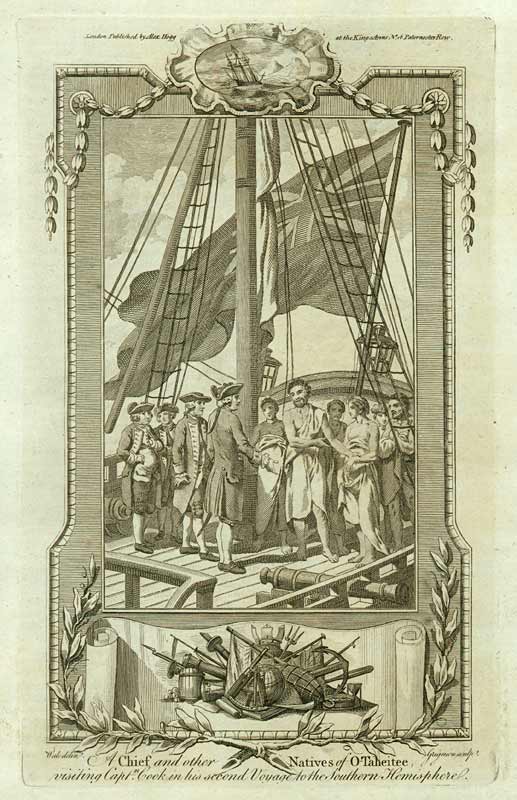
Weep, unhappy Tahitians! Weep, not for the
going but for the coming of those wicked and
ambitious men. One day you will know them better. There will come a day when
they return, in one hand the scrap of wood you see hanging at this man's girdle,
in the other the steel you see at that man's side, to bind you in chains, to cut
your throats, or enslave you to their whims and vices. One day you will be their
servants and as corrupt, as vile, as miserable as them.
It is finally necessary to reject the idea of corruption, since it
presupposes the mistaken identification of the undisturbed native with the
“natural man.” But it is just as important to recognize that, in the hands of
one Enlightenment thinker, both that idea and its presupposition served as
intellectual weapons against Western colonialism.
5.
James Cook was not as determined an opponent of colonialism as Diderot,
but he was certainly skeptical about the benefits contact with the West was
supposed to bring to indigenous peoples. In the journals he kept during his
second stay on Tahiti, he wrote of the islanders:
… we debauch their morals already prone to
vice and we introduce among them wants and perhaps diseases which they never
before knew and which serve only to disturb that happy tranquility they and
their forefathers had enjoyed. If anyone denies the truth of this assertion let
him tell what the natives of the whole extent of America have gained by the commerce they had had with
Europeans.
This skeptical sentiment is especially remarkable considering the fact
that Cook was on a mission of colonial expansion. His voyages of discovery began
with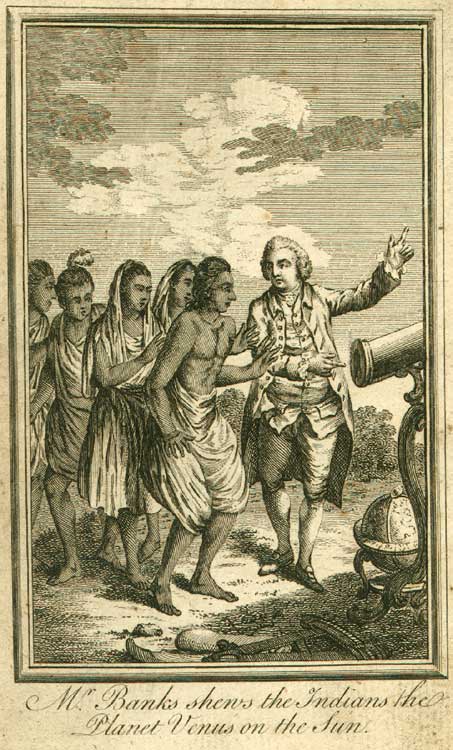 the ostensible goal of conducting an
experiment in astronomical observation. On June 3, 1769, the planet Venus was
due to make one of its infrequent transits across the disc of the sun. Some
astronomers believed that, if the time required for the transit could be
measured from two widely separated geographical points, then the distance of the
earth from the sun could be calculated. The Royal Society petitioned the British
Crown to fund a voyage to the Southern Hemisphere for the purpose of making one
of the two measurements. The Crown granted the request, purchased a collier for
the voyage, equipped it with the precision quadrant, telescopes, and chronometer
necessary to set up an observatory on Tahiti, and placed the forty year-old
veteran of the French and Indian War, James Cook, in command of the mission. But
it also provided Cook with secret instructions to continue his voyage beyond
Tahiti to see if he could discover the Southern Continent. While taking care not
to incite the natives, he was to claim whatever territory he could in the name
of the Crown. Cook failed to find the Continent and indeed eventually
demonstrated its apocryphal character. But he did manage to claim the eastern
coast of Australia as British territory, discover the Hawaiian Islands, and map
much of the South Pacific with a considerable degree of
accuracy.
the ostensible goal of conducting an
experiment in astronomical observation. On June 3, 1769, the planet Venus was
due to make one of its infrequent transits across the disc of the sun. Some
astronomers believed that, if the time required for the transit could be
measured from two widely separated geographical points, then the distance of the
earth from the sun could be calculated. The Royal Society petitioned the British
Crown to fund a voyage to the Southern Hemisphere for the purpose of making one
of the two measurements. The Crown granted the request, purchased a collier for
the voyage, equipped it with the precision quadrant, telescopes, and chronometer
necessary to set up an observatory on Tahiti, and placed the forty year-old
veteran of the French and Indian War, James Cook, in command of the mission. But
it also provided Cook with secret instructions to continue his voyage beyond
Tahiti to see if he could discover the Southern Continent. While taking care not
to incite the natives, he was to claim whatever territory he could in the name
of the Crown. Cook failed to find the Continent and indeed eventually
demonstrated its apocryphal character. But he did manage to claim the eastern
coast of Australia as British territory, discover the Hawaiian Islands, and map
much of the South Pacific with a considerable degree of
accuracy.
This is not to suggest that the scientific aspect of Cook's voyages was
merely a cover for colonial expansion. The intense public interest in the
voyages, at least, was focused on their scientific significance. The Royal
Society had done more than make certain that the first voyage was equipped to
conduct a delicate astronomical observation. It also assigned one of its
Fellows, Joseph Banks, to the journey in order to collect botanical, zoological,
and other natural historical information. From his private fortune, Banks
recruited a scientific team that included the botanist and pupil of Linnaeus,
Daniel Carl Solander, the landscape painter, Alexander Buchan, the natural
history draftsman, Sydney Parkinson, and a scientific secretary, Herman
SpÀ?_Àring. These researchers collected thousands of plant, animal, and mineral
specimens, made drawings and paintings of flora, fauna, geological formations,
and whole landscapes, and compiled written observations on a wide range of
natural historical phenomena. In many of these efforts, the team and its
equivalent on subsequent voyages were guided by the Linnaean Systema
Naturae. (Linnaeus himself had been invited to serve as chief naturalist on
the first voyage, but declined). The Systema provided a taxonomic
framework and the associated terminological precision necessary for bringing
conceptual order to biological entities that no European had seen before. Like
one of the organisms that it sought to classify, it had the unique property of
being able to grow organically with the development of new branches and
sub-branches. Moreover, it perspicuously identified the criteria, primarily
those pertaining to sexual reproduction, which allowed the categories of living
things to be distinguished from one another in terms of kingdoms, orders,
classes, genera, and species. Outfitted with this supple theoretical tool, Banks
and his associates were able to classify the plant and animal denizens of the
strange islands they visited, and communicate that systematic information to the
interested public back home.
There was no conceptual framework, comparable in its logical power, for
making sense of the human beings encountered on the three voyages. It is true
that Linnaean taxonomy could be directly applied to human populations. All that
one had to do was correlate the concept of the species or, more reasonably, the
subspecies with the idea of race. In such a fashion, cultural differences among
peoples could be attributed to divergent biological factors. But that fateful
step, which led in its most consistent form to the development of “scientific
racism,” was not taken until the nineteenth century. What was available instead
by the time of Cook's voyages was the moral-political concept of the savage as
“natural man,” and that idea was undoubtedly an influence on the way the
European visitors regarded the peoples of the South Pacific. But as we have
seen, the concept was framed for the purposes of social criticism, not those of
concrete ethnographic work. The fact is that, in their attempt to record and
explain the appearances, customs, technologies, beliefs, and political systems
of Oceanic natives, Cook and the scientists who accompanied him simply muddled
along as best they could.
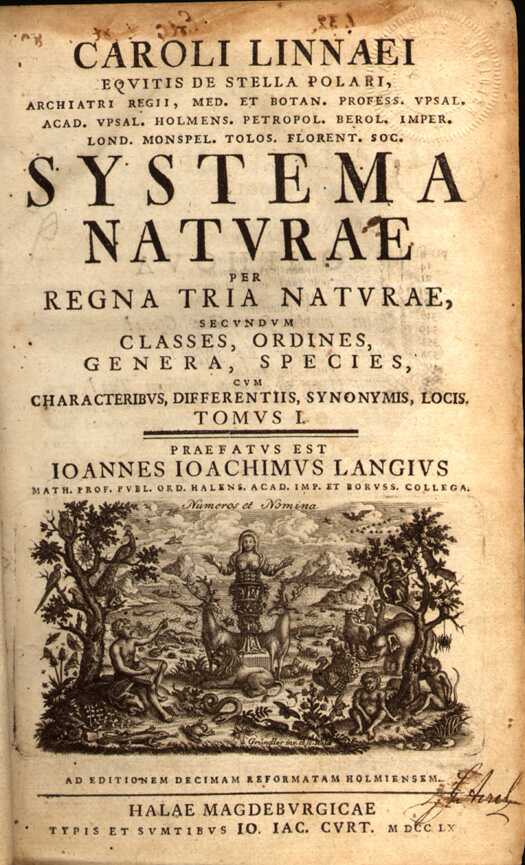 The disparity between the explorers' sophisticated natural history and
their rough and ready attempts at ethnography is reflected in the corresponding
collections brought back to England. Several thousand natural history specimens
were collected under the direction of Banks, including plants, birds, fish,
insects, shells, and pieces of coral. They were classified approximately in the
field in accordance with the Systema Naturae, and were subsequently
assigned the appropriate Latin binomial nomenclature. By the time they were
exhibited in London, donated to wealthy patrons, or offered for sale, they had
already been more or less thoroughly exposed to the light of reason. Perhaps it
was because of this ability to introduce order into the chaotic profusion of
tropical organisms, and so to make sense of a part of the world that threatened
to escape European comprehension, that the natural history collections stirred
wider and more enthusiastic public interest than any other aspect of the
voyages.
The disparity between the explorers' sophisticated natural history and
their rough and ready attempts at ethnography is reflected in the corresponding
collections brought back to England. Several thousand natural history specimens
were collected under the direction of Banks, including plants, birds, fish,
insects, shells, and pieces of coral. They were classified approximately in the
field in accordance with the Systema Naturae, and were subsequently
assigned the appropriate Latin binomial nomenclature. By the time they were
exhibited in London, donated to wealthy patrons, or offered for sale, they had
already been more or less thoroughly exposed to the light of reason. Perhaps it
was because of this ability to introduce order into the chaotic profusion of
tropical organisms, and so to make sense of a part of the world that threatened
to escape European comprehension, that the natural history collections stirred
wider and more enthusiastic public interest than any other aspect of the
voyages.
The ethnographic objects were not so highly regarded. This was not for
any lack of items. More than two thousand objects were collected on the three
voyages. In addition, an attempt was made by the collectors to be as
comprehensive as possible given the limitations of time, geography, and
willingness to trade on the part of the natives. In reviewing what survives of
the objects today, there is no mistaking the principle behind their selection.
Basic categories of objects were identified, and the scientists, if not the
sailors, on board tried to acquire several examples of each type. In many cases,
the islanders were willing to part with ceremonial as well as utilitarian
objects. Thus the sheer range of items is impressive. Feather gods, wicker
helmets, bowls with human images, ivory hook pendants, temple carvings, shark
tooth implements, ornamented bark cloth from Hawaii; mourning dresses, feather
gorgets, ear ornaments, neck rests, tattooing needles, sennit god images, bark
cloth beaters, carved fly whisk handles from Tahiti; carved staves, feather
headdresses, bone ornaments, dance paddles from Easter Island; baskets,
greenstone talismans, necklaces, whalebone combs, war clubs, bone and wooden
flutes, hafted adzes from New Zealand; food pounders, wooden vessels, decorative
girdles, leg ornaments, ivory images, pan pipes, nose flutes, octopus lures from
the Tongan Island ─ these are only a few of the categories
exemplified.
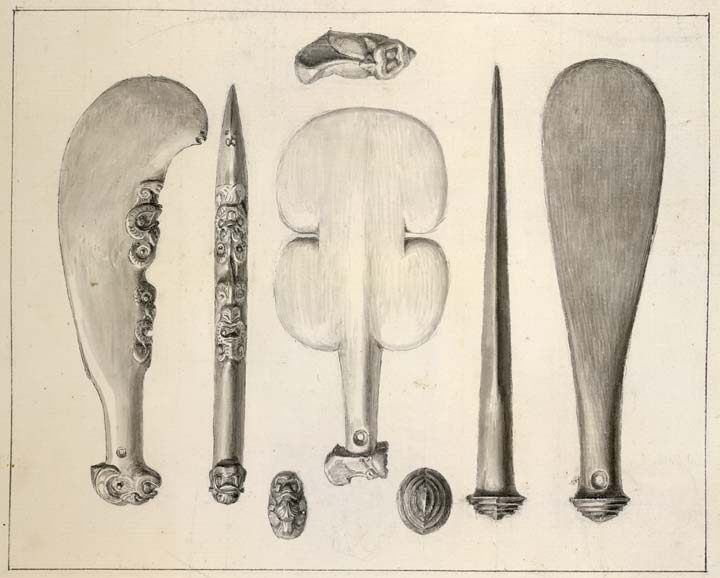
What was missing was
not specimens of the material
culture of Oceania, but a rational principle that could introduce order into the
proliferation of ethnographic forms, just as the Systema Naturae had
introduced order into the profusion of biological entities. Here the
Enlightenment propensity to see the savage as a child of nature, however
construed, blocked any possible path to understanding. For the tools, clothing,
ornaments, and ceremonial objects that Cook and his scientists collected had not
grown spontaneously from tropical soil. They were the meaningful products of
socially organized activity, and therefore required principles of explanation
quite different than those of biological taxonomy. In the absence of this
recognition, there was no way to ward off the chaos with which the Oceanic
objects threatened the European mind. It is not surprising, therefore, that very
little interest was stirred in the public by the ethnographic collections. There
was only an anemic market for the objects, even on the part of the nascent
museums. Many of them have been lost since they were first transported to
London, and some undoubtedly exist in contemporary collections without any
indication of their provenance in Cook's famous voyages.
6.
The passive disappearance of artifacts from the collections brought back
by Cook was not the only loss of Oceanic objects that resulted from his
expeditions. His landing on Hawaii set off a chain of events that led to a far
more dramatic and widespread destruction of works of indigenous art.
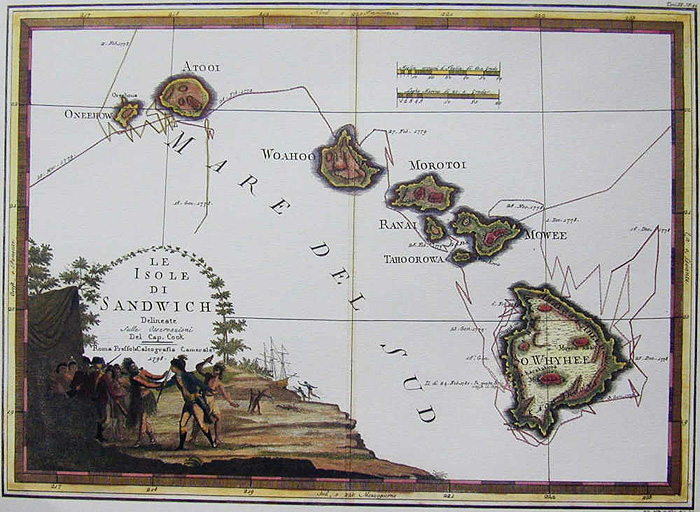 According to current archeological findings, when Cook first came upon
the Hawaiian Islands they had been inhabited for roughly two thousand years.
They
seem to have been colonized by two waves of Polynesian immigrants, an earlier
group from the Marquesas Islands and a later group from the Society Islands,
which include Tahiti. The Tahitian influence in particular left its imprint on
the Hawaiian social order in the form of a rigidly hierarchical system of class differentiation. As in Tahiti, the most important division was
the one that separated a class of hereditary nobles or chiefs, known in Hawaii
as the ali'i, from a class of commoners, known as the maka'ainana.
As the English visitors were quick to recognize, the ali’i were ranked in
a way somewhat similar to the European nobility, with the rank order culminating
at its apex in the paramount chief, or king, the ali'i
nui.
According to current archeological findings, when Cook first came upon
the Hawaiian Islands they had been inhabited for roughly two thousand years.
They
seem to have been colonized by two waves of Polynesian immigrants, an earlier
group from the Marquesas Islands and a later group from the Society Islands,
which include Tahiti. The Tahitian influence in particular left its imprint on
the Hawaiian social order in the form of a rigidly hierarchical system of class differentiation. As in Tahiti, the most important division was
the one that separated a class of hereditary nobles or chiefs, known in Hawaii
as the ali'i, from a class of commoners, known as the maka'ainana.
As the English visitors were quick to recognize, the ali’i were ranked in
a way somewhat similar to the European nobility, with the rank order culminating
at its apex in the paramount chief, or king, the ali'i
nui.
When Cook arrived, most of the eight inhabited islands in the Hawaiian
chain accommodated more than one ali’i nui, although the island for which
the entire chain was eventually named, Hawaii, was under the control of a single
paramount chief, Kalani'opu'u. On every island the paramount chiefs controlled
the distribution of land among the population, although they delegated
administrative power over districts and sub-districts to appropriately ranked
members of the subordinate nobility. The basic unit of land, the 'ili,
was occupied by an extended family of commoners who had the right to use it for
fishing and for cultivating such crops as taro, yams, coconuts, breadfruit, and
bananas. Yet the right was not permanent. It existed only as long as the family
met its responsibilities in tribute and labor to the district chiefs and in
military service to the king. In addition to the two major classes of nobility
and commoners, there may also have been a middle class comprised of priests and
skilled artisans. Finally there may have existed an underclass of pariahs may
that supplied slaves to commoner families and sacrificial victims for religious
ceremonies. (The existence and nature of a middle class as well as an underclass
remain a topic of dispute among experts.)
The ideological justification of the class hierarchy was supplied by what
we can only call the Hawaiian “religion.” As in most of the pre-capitalist
world, however, it is important to keep in mind the fact that this word does not
refer to a specialized institution, but to beliefs and practices that permeated
all of social life. According to the traditional religion in this broad sense of
the term, the nobility belonged to the same genealogical line as the gods. As a
consequence of their semi-divine status, nobles were charged with a spiritual
power known as mana.
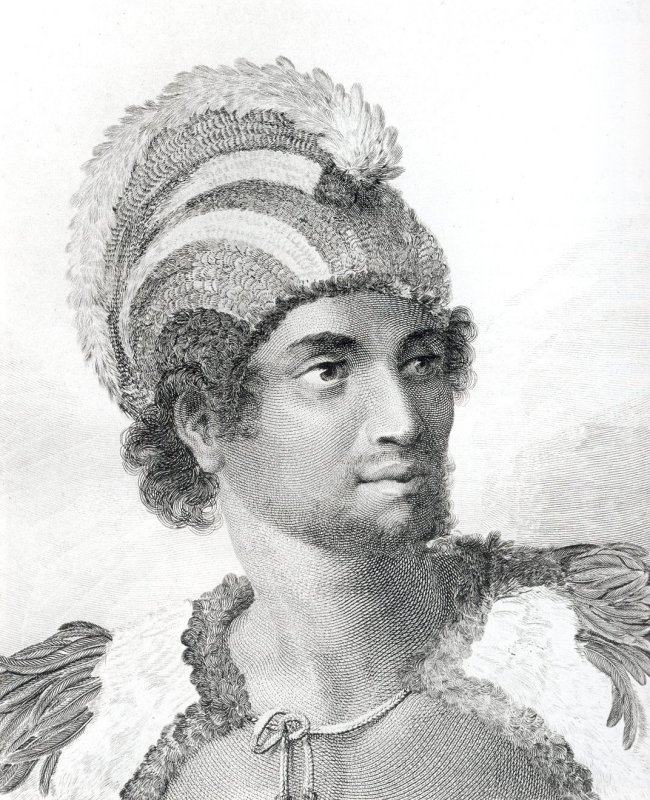 Mana has always appeared
paradoxical to anthropologists. It is both a quasi-physical substance, a
quantity that can be accumulated through a variety of procedures and transmitted
from one person or object to another, and an abstract quality equivalent to
efficacy, success, or luck. But however difficult it may be to grasp its
objective meaning, its social function is quite clear. Mana could be
tolerated by the highborn, but it had disastrous consequences for any commoner
who came into contact with it. The system of kapu (taboo) was developed
in order to prevent this powerful invisible force from being communicated from
superior to inferior. In the famous if somewhat unusual example, if even the
shadow of an ali nui fell on the house of a commoner, then the house had
to be destroyed. In a more pedestrian example, commoners were required to fall
on their faces when the higher nobles passed before them lest the mana of
their godlike superiors be discharged by means of a shared glance. But it was
not just the body of a noble that was kapu to the lowborn. So were all of
the noble's privileges. Here the social significance of kapu becomes
evident. Its underlying purpose was not at all to protect the commoner from the
dangerous mana of the noble, but to protect the noble from the even more
dangerous claims to equality on the part of the commoner. In terms of the
kapu system, such potential egalitarian impulses were not so much social
impertinences as transgressions against a spiritual power that had its ultimate
origin in Kahiki, the home of the gods. For the traditional religion, the class
system of Hawaii was not a transient human creation. It was part of the
invariant order of the cosmos.
Mana has always appeared
paradoxical to anthropologists. It is both a quasi-physical substance, a
quantity that can be accumulated through a variety of procedures and transmitted
from one person or object to another, and an abstract quality equivalent to
efficacy, success, or luck. But however difficult it may be to grasp its
objective meaning, its social function is quite clear. Mana could be
tolerated by the highborn, but it had disastrous consequences for any commoner
who came into contact with it. The system of kapu (taboo) was developed
in order to prevent this powerful invisible force from being communicated from
superior to inferior. In the famous if somewhat unusual example, if even the
shadow of an ali nui fell on the house of a commoner, then the house had
to be destroyed. In a more pedestrian example, commoners were required to fall
on their faces when the higher nobles passed before them lest the mana of
their godlike superiors be discharged by means of a shared glance. But it was
not just the body of a noble that was kapu to the lowborn. So were all of
the noble's privileges. Here the social significance of kapu becomes
evident. Its underlying purpose was not at all to protect the commoner from the
dangerous mana of the noble, but to protect the noble from the even more
dangerous claims to equality on the part of the commoner. In terms of the
kapu system, such potential egalitarian impulses were not so much social
impertinences as transgressions against a spiritual power that had its ultimate
origin in Kahiki, the home of the gods. For the traditional religion, the class
system of Hawaii was not a transient human creation. It was part of the
invariant order of the cosmos.
The Hawaiian chant, the Kumulipo, was composed and sung to mark the birth
of the ali’i nui, Kalaninui`iamamao. It affirms the legitimacy of the
infant prince by reciting his genealogy and, at the same time, describes the
origins of the cosmos. These two themes are intimately connected because people,
as represented by the nobility, share a common origin with the gods. In the
first epoch of cosmogenesis, Po (Night),
neither personified gods nor human beings are present. At this time more ancient
than any other, the heavens warm the earth by rubbing against it, producing
walewale, a generative slime or sap that gives rise to
Po. In turn,
Po
transforms itself into
a double manifestation as the male principle, Kumulipo and the female principle,
Po`ele. The coupling of these two pre-personal divine forces results in the
birth of the most primitive of biological species, including corals and
mollusks. The coupling of a second dual male and female manifestation of the
generative principle, Po, produces fish; that of a third manifestation,
insects and birds; that of a fourth, amphibians; that of a fifth, pigs; that of
a sixth, rats; that of a seventh, dogs; and that of an eighth, human beings. The
appearance of humankind signifies the transition from the first cosmic epoch,
Po, to the
second, Ao (Day). The second epoch belongs, not to impersonal forces, but
to personified beings, both human and divine. The same coupling that engenders
the primordial human pair produces two of the principal gods of the Hawaiian
pantheon, Kane and Kanaloa.
Born was La`ila`i a woman.
Born was Ki`i a man.
Born was Kane a god.
Born was Kanaloa the hot-striking
octopus.
It was day
Both the gods and the human male need the woman, La`ila`i, in order to
engender children. The man, Ki`i, however, is the first to gain access to her
reproductive powers. According to the chant, then, the first gods and human
beings are siblings, but the lineages they found differ by order of priority.
The lineage of human beings is actually older then, and therefore superior to,
that of the gods.
In his interpretation of the Kumulipo, Valerio Valeri
points out that this open expression of human superiority is exceptional in
Hawaiian theology.
The relationship between human and divine beings is actually ambivalent. The
myth that proclaims human superiority demonstrates by its very existence that
people cannot do without the gods. There is a kind of shifting balance of power
between the two in which now one and now the other seems to have the upper hand.
People need the gods for a variety of reasons, including the utilitarian ones of
ensuring success in farming, warfare, childbirth, and so on. But gods need human
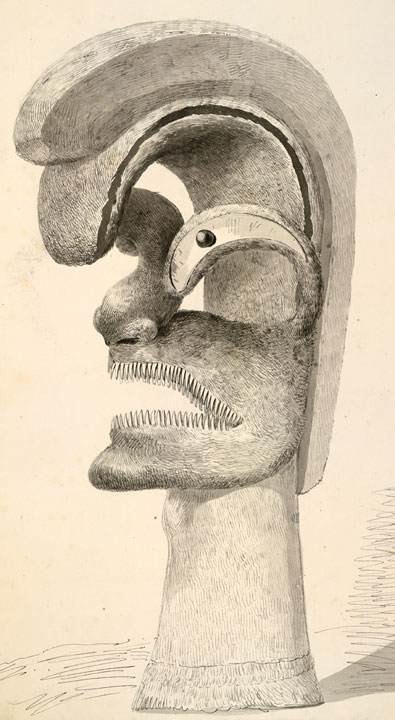 beings as instruments of their own personalization. In this
respect, the name of the first human male is significant. Ki`i is the
Hawaiian word for the images of the gods, either in wood or featherwork, that
stand at the center of worship and ritual. The essential function of human
beings from a religious perspective is to produce these images, for the images
are the vehicles by means of which the impersonal divine forces of the first
cosmic epoch transform themselves into the personified gods of the second one,
and so enter into the individuating light of Day.
beings as instruments of their own personalization. In this
respect, the name of the first human male is significant. Ki`i is the
Hawaiian word for the images of the gods, either in wood or featherwork, that
stand at the center of worship and ritual. The essential function of human
beings from a religious perspective is to produce these images, for the images
are the vehicles by means of which the impersonal divine forces of the first
cosmic epoch transform themselves into the personified gods of the second one,
and so enter into the individuating light of Day.
I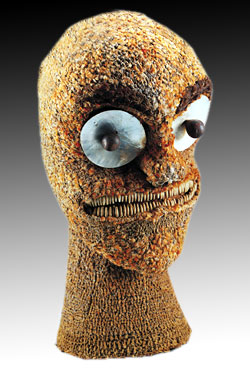 n its original sense, theosophy is a description of the dynamic
unfolding of the divine life as represented in the West by the work of mystics,
philosophers, and poets such as Jacob Boehme, Friedrich Schelling, and William
Blake. Only subsequently did it come to refer to a rather crude form of
nineteenth century occultism.
If we take the word in its original meaning, then the Hawaiian art of making
images of the gods has a theosophical significance. It is part of the inner
life-process in the course of which an Absolute Reality that is undifferentiated
at the outset expresses itself in the form of a well defined multiplicity of
personal deities.
n its original sense, theosophy is a description of the dynamic
unfolding of the divine life as represented in the West by the work of mystics,
philosophers, and poets such as Jacob Boehme, Friedrich Schelling, and William
Blake. Only subsequently did it come to refer to a rather crude form of
nineteenth century occultism.
If we take the word in its original meaning, then the Hawaiian art of making
images of the gods has a theosophical significance. It is part of the inner
life-process in the course of which an Absolute Reality that is undifferentiated
at the outset expresses itself in the form of a well defined multiplicity of
personal deities.
Naturally, the artists responsible for creating such
images were also ritual specialists. The kahuna in general were priests,
experts empowered to officiate at religious ceremonies. The makers of divine
images were a subcategory of that group, kahuna kahai, priest-sculptors.
They were trained in the crafts of carving and featherwork in the course of
which they mastered both technical skills and the language of bold volumetric
forms characteristic of Hawaiian sculpture. They were also taught the prayers
and rituals necessary for focusing the divine life into determinate,
anthropomorphic shapes, thereby putting an end to its anonymous diffusion. They
were not only artists, but representatives of humankind in its most essential,
theosophical capacity.
The ritual formality that accompanied artistic activity was especially
pronounced with respect to the carving and decoration of the central image of
the luakini, a 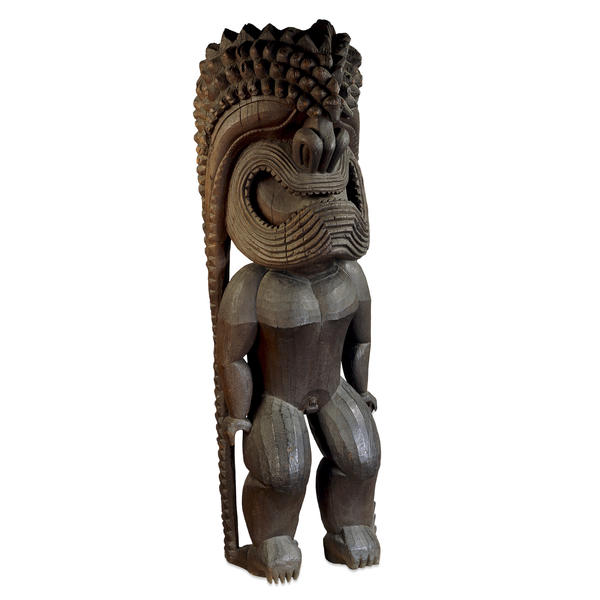 temple that was devoted to Ku,
the god of war, and could only be built at the command of the ali’i nui.
According to early accounts by Hawaiian informants, when the time came to make the central image,
the king led an entourage of nobles and priests to the most elevated mountain
slopes where they located
a suitable 'ohi'a tree. After one of the priests said a prayer
consecrating the adze that would be used to fell the tree,
the king dashed a pig to
the ground, offering it as a sacrifice. That offering was followed by another,
more significant one when a criminal violator of kapu was brought forth
and beheaded. After the tree was felled, the criminal's body was buried at its
root, while the kahuna kahai set to work carving the image of the god
into the trunk of the tree. The completed sculpture was then carried in solemn
procession to the luakini temple, where another kapu violator was
sacrificed and thrust into the hole reserved for the image. The following
morning, a girdle of braided coconut leaves placed around the belly of the
statue as an umbilical cord was cut by a priest while he recited prayers. The
ritual came to a conclusion as the statue was girded with a loincloth of
beaten bark. In this fashion, by means of ritual observances the god, Ku, was
born in the form of a work of art. We need to take this formulation literally.
The image was not a sign, an indicator that referred the attention of the viewer
away from its own material presence toward the very different, invisible being
of the deity. It was the god himself in one of his concrete manifestations.
temple that was devoted to Ku,
the god of war, and could only be built at the command of the ali’i nui.
According to early accounts by Hawaiian informants, when the time came to make the central image,
the king led an entourage of nobles and priests to the most elevated mountain
slopes where they located
a suitable 'ohi'a tree. After one of the priests said a prayer
consecrating the adze that would be used to fell the tree,
the king dashed a pig to
the ground, offering it as a sacrifice. That offering was followed by another,
more significant one when a criminal violator of kapu was brought forth
and beheaded. After the tree was felled, the criminal's body was buried at its
root, while the kahuna kahai set to work carving the image of the god
into the trunk of the tree. The completed sculpture was then carried in solemn
procession to the luakini temple, where another kapu violator was
sacrificed and thrust into the hole reserved for the image. The following
morning, a girdle of braided coconut leaves placed around the belly of the
statue as an umbilical cord was cut by a priest while he recited prayers. The
ritual came to a conclusion as the statue was girded with a loincloth of
beaten bark. In this fashion, by means of ritual observances the god, Ku, was
born in the form of a work of art. We need to take this formulation literally.
The image was not a sign, an indicator that referred the attention of the viewer
away from its own material presence toward the very different, invisible being
of the deity. It was the god himself in one of his concrete manifestations.
Cook discovered the Hawaiian Islands accidentally on his
third voyage. In two ships, the Resolution and the Discovery, he and his
contingent of scientists and sailors embarked on the long and tedious journey
from Tahiti to the northwest coast of America in early December
1777.
About a month later, after crossing the equator into northern waters, the party
sighted a chain of volcanic isles. On nearing land, they were met by canoes
filled with people whom Cook immediately recognized as Polynesians, relatives of
the Tahitians, Maoris, and so forth previously encountered in the southern Pacific. Some of the people came on
board, though Cook allowed no women into the ships in an attempt to protect the
Hawaiians from the “venereal distemper” that his men had already carried to Tahiti and the
other Society Islands. After anchoring off Kauai, he went ashore where he was
received with great veneration. Wherever he walked, people prostrated themselves before him and did not
rise until he signaled them to do so.
The first visit lasted only two weeks, though the Englishmen returned to
Hawaii in November 1778, after having explored the Arctic Ocean. On this
occasion, Cook ordered the ships to cruise off the islands for seven weeks
before he finally allowed them to anchor at Kealakekua Bay on the island of
Hawaii. His purpose in the delay was once again to prevent the spread of
venereal disease. But the unhappiness of his crew, combined with the remarkably
insistent overtures of the Hawaiian women, made this impossible. He had to allow
his men ashore and even permitted women to sleep with the sailors on board. Cook
himself resisted these erotic enticements and was sometimes taunted by
disappointed women for his decision to abstain. But such momentary disrespect
did not prevent him from being received with the same veneration that
characterized his first visit. He was greeted with considerable fanfare by
chieftains and priests, and the common people continued to fall on their faces
whenever he happened to pass by.
Cook was unaware of the reason for his veneration by the
Hawaiians. On both of his visits, he arrived during the
Makahiki season in which the land is renewed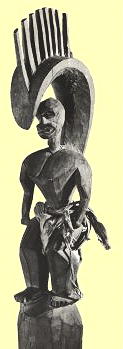
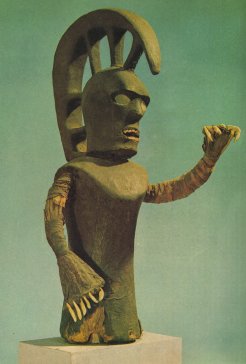 by the southern rainstorms of winter,
marking the transition from the old to the new year. In Hawaii, the
revitalization of nature was associated with the return to earth of the god,
Lono, from his celestial home in kahiki. According to the myth, Lono once fell
in love with a beautiful mortal woman and married her after descending from the
sky by traveling along the arch of a rainbow. Though the two lived happily for a
while in Kealakekua, the god's jealousy soon brought disaster upon the couple.
Believing that his wife had been unfaithful with a human male, Lono beat her so
badly that she died, but not before she had time to convince him of her
innocence. Driven mad by grief and remorse, the god traveled throughout Hawaii,
boxing with the men he encountered along the way. When he had finally traversed
every district in the islands, he boarded a canoe which the people had filled
with provisions. As he departed, he promised to return one day bearing coconuts,
pigs, birds, and other foods. With a complicated series of rituals, the three
month Makahiki season marked the return of Lono and the fertilization of
his new bride, the land.
by the southern rainstorms of winter,
marking the transition from the old to the new year. In Hawaii, the
revitalization of nature was associated with the return to earth of the god,
Lono, from his celestial home in kahiki. According to the myth, Lono once fell
in love with a beautiful mortal woman and married her after descending from the
sky by traveling along the arch of a rainbow. Though the two lived happily for a
while in Kealakekua, the god's jealousy soon brought disaster upon the couple.
Believing that his wife had been unfaithful with a human male, Lono beat her so
badly that she died, but not before she had time to convince him of her
innocence. Driven mad by grief and remorse, the god traveled throughout Hawaii,
boxing with the men he encountered along the way. When he had finally traversed
every district in the islands, he boarded a canoe which the people had filled
with provisions. As he departed, he promised to return one day bearing coconuts,
pigs, birds, and other foods. With a complicated series of rituals, the three
month Makahiki season marked the return of Lono and the fertilization of
his new bride, the land.
The Hawaiians saw Cook as a human manifestation of Lono. It is easy to
see why. To begin with, he arrived from the sea, reversing the direction of
Lono's departure. He also landed at Kealakakua, where the ill fated couple once
resided. And there was yet another astonishing concordance. The masts of Cook's
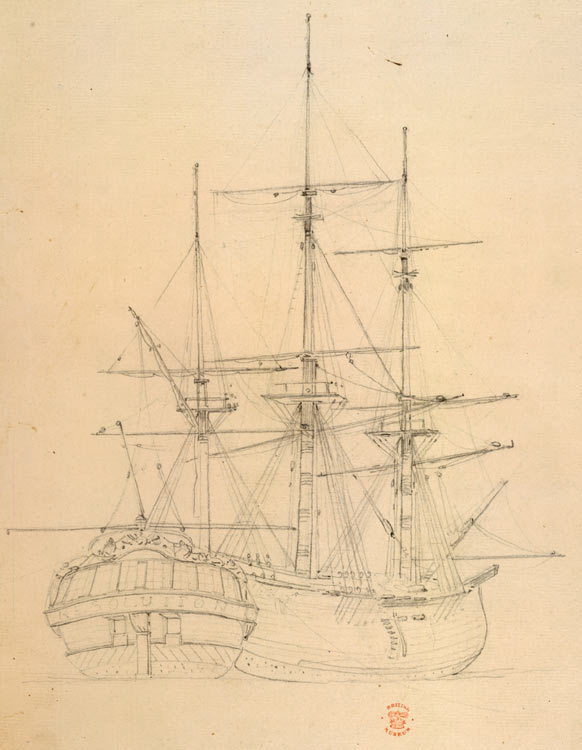 ships resembled the image of Lono that
was carried around the island during the Makahiki festival, repeating the
god's original circuit in the period of his madness. Each year the image made
its first appearance after a night of celebration that ended in an orgy meant,
no doubt, to evoke the generative powers of the god. When the people finished
making love to one another in the ocean's surf, they turned to behold the statue
of Lono standing higher up on the shore. The statue was in the form of an
akua loa, a “long god.” It consisted in a pole as much as seventeen feet
in length, the top of which was carved in the image of the deity. Though the
image may sometimes have consisted in a full anthropomorphic figure, the sole
surviving example of an akua loa depicts only the god's head, and this at
the comparatively minuscule length of two and a half inches. From a crosspiece
attached to the pole hung the skins of migratory birds, species that were
counted among Lono's “myriad bodies” since they returned with the southern
storms that revived the earth in winter. The skins were accompanied by feather
streamers and pieces of bark cloth. Not only did Cook's masts resemble the pole
and crosspiece of the statue, but his sails corresponded to the streamers and
bark cloth which, like them, sometimes billowed in the wind.
ships resembled the image of Lono that
was carried around the island during the Makahiki festival, repeating the
god's original circuit in the period of his madness. Each year the image made
its first appearance after a night of celebration that ended in an orgy meant,
no doubt, to evoke the generative powers of the god. When the people finished
making love to one another in the ocean's surf, they turned to behold the statue
of Lono standing higher up on the shore. The statue was in the form of an
akua loa, a “long god.” It consisted in a pole as much as seventeen feet
in length, the top of which was carved in the image of the deity. Though the
image may sometimes have consisted in a full anthropomorphic figure, the sole
surviving example of an akua loa depicts only the god's head, and this at
the comparatively minuscule length of two and a half inches. From a crosspiece
attached to the pole hung the skins of migratory birds, species that were
counted among Lono's “myriad bodies” since they returned with the southern
storms that revived the earth in winter. The skins were accompanied by feather
streamers and pieces of bark cloth. Not only did Cook's masts resemble the pole
and crosspiece of the statue, but his sails corresponded to the streamers and
bark cloth which, like them, sometimes billowed in the wind.
In a rite conducted at a luakini temple shortly after his arrival
at Kealakakua Bay, Cook's body was also assimilated to the image of Lono.
According to the journal kept by Lt. James King, when Cook first went ashore he
was greeted by four priests holding wands tipped with dog hair. The priests led
him and his small party on a procession past commoners who lay face down on the
ground, while the priests repeated a short sentence in which the Englishmen
could discern only the word, Orono, which was the way they heard the name, Lono.
The procession led to a temple complex consisting in a large, tiered platform of
sto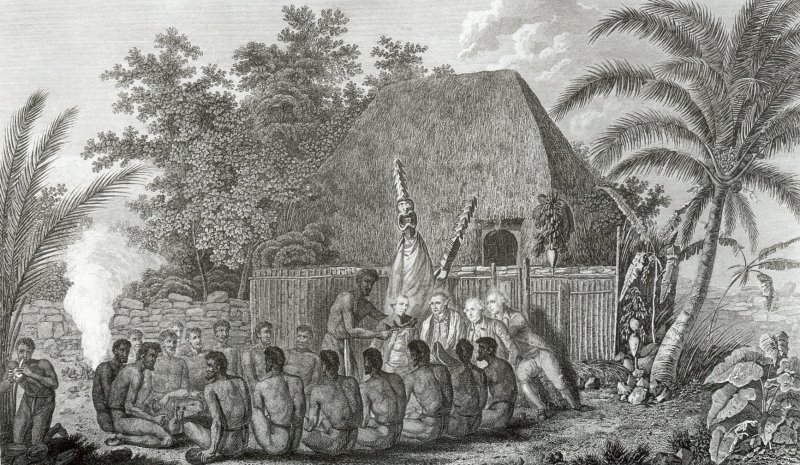 ne surrounded by a wooden rail on which
were fixed the skulls of captives who had been sacrificed on the deaths of their
chiefs. The priests brought Cook through the entrance, where two wooden images
stood guard, and into the interior of the complex, where twelve more images were
arranged in a semicircle. Cook was draped in a red cloth similar to the one worn
by the central image, which he kissed in imitation of the head priest, Koah. He
was then led into another part of the complex, where he descended into a square
space sunken three feet into the ground. There he was seated between two
additional statues. As Koah held one of his arms and Lt. King supported the
other, Cook's body was made to assume the shape of the long god, the
Makahiki image of Lono.
ne surrounded by a wooden rail on which
were fixed the skulls of captives who had been sacrificed on the deaths of their
chiefs. The priests brought Cook through the entrance, where two wooden images
stood guard, and into the interior of the complex, where twelve more images were
arranged in a semicircle. Cook was draped in a red cloth similar to the one worn
by the central image, which he kissed in imitation of the head priest, Koah. He
was then led into another part of the complex, where he descended into a square
space sunken three feet into the ground. There he was seated between two
additional statues. As Koah held one of his arms and Lt. King supported the
other, Cook's body was made to assume the shape of the long god, the
Makahiki image of Lono.
In his journal, Lt. King confessed his ignorance concerning the precise
meaning of the ritual. Still he understood that it endowed Cook with an exalted
religious significance.
The meaning of the various ceremonies, with
which we had been received … can only be the subject of conjectures, and those
uncertain and partial: they were, however, without doubt, expressive of high
respect on the part of the natives; and, as far as related to the person of
Captain Cook, they seemed approaching to adoration.
Cook also surely knew that he was being treated like a god. But the odd
fact is that he exhibited so little curiosity about the precise meaning of that
treatment. Nor did he make any attempt to resist a deification whose
significance ultimately escaped him. He blindly played the role he had been
allotted by his hosts. The reason for his passive attitude in this regard is
clear. He was happy in the knowledge that the natives were well disposed to him
and his crew. That complacency was his undoing.
The Makahiki festival was built on the rivalry between Lono and
the ali’i nui. At the beginning of the festival, the king relinquished
his power to the image of Lono by placing his whale tooth pendant, symbol of
royal authority, around the statue's neck. He then confined himself to his house
until the festival was near its conclusion, abandoning his kingdom for the
intervening period of time to the will of the god. Many of the usual taboos were
suspended in the carnival atmosphere that ensued, including prohibitions against
indiscriminate sexual contact, as well as demands that commoners exhibit respect
for the nobility. But these taboos were replaced with different ones concerning
access to the bounty of the land. The harvesting of fruits and vegetables in a
district was prohibited until a portion of the crop was given to Lono and found
acceptable by his priests. At such time, the long god, or akua loa, was
turned face downward, and replaced with a similar image, called an akua
pa`ani. Celebrants used the substitute image to preside over sports and
dancing, including ritual boxing between representatives of the god and those of
the people. The Akua loa was then moved to the boarder of the next
district where the same sequence of events was repeated. When the entire island
had been traversed, the king came out of seclusion. He boarded a canoe that
headed toward the ocean and then reversed its course to shore. When he stepped
onto land, a group of Lono's attendants barred his way to keep him from reaching
the god. One of these men threw a spear at the king, which was warded off by one
of the latter's champions. A second man touched the body of the king with
another spear, thereby symbolically killing him. But the king was also reborn.
After a mock battle between his party and that of the god, the ali’i nui
brought the images of Lono used in the festival into the temple from which
they had originated. There they were taken down and stored, symbolically killing
the god, who, of course, would be reborn the following year. In this way, the
king completed the process through which Lono was driven from the land after
renewing it, thereby liberating its bounty for the use of human
beings.
Lt. King remarks in his journal that, after the Englishmen had stayed for
three weeks on Hawaii, the priests began to inquire anxiously as to when they
would be ready to depart
the island. Unbeknownst to Cook and his men, it was now near the conclusion of
the Makahiki
festival when the god must be banished, the king reassume political power, and
the fruits of the earth return to the people. Cook obliged his hosts by setting 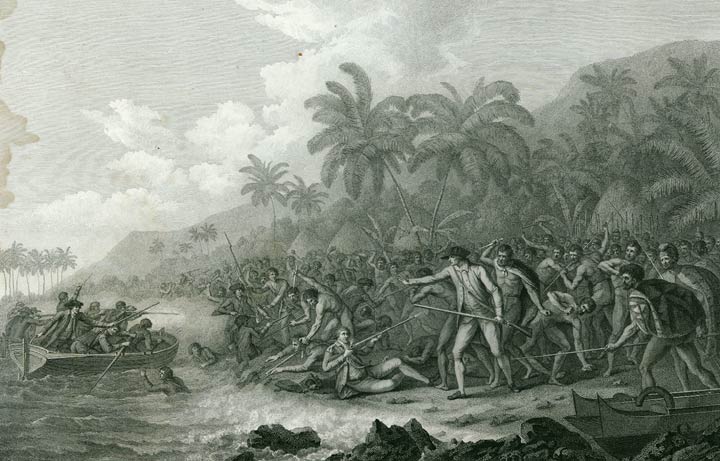 sail on February 4.
But as luck would have it, only three days later the Resolution's foremast was
sprung, leaving the ship with the use of only half her sails. The Englishmen
returned to Kealakaua Bay and set to work making repairs. But this time, the
attitude of the natives had become decidedly unfavorable. They were dissatisfied
when told the reason for the return, and began to express contempt for the
visitors who were now out of phase with the ritual cycle. Innumerable acts of
theft occurred. When the Discovery's cutter, which served as its lifeboat, was
stolen one night, Cook reached the limits of his patience. He decided to use a
ploy that had been successful on other islands by taking and holding a hostage until the cutter was
returned. With a party of marines, he went ashore in search of the ali’i
nui, Kalei'opu'u. However, when he tried to convince the king to accompany
him back to the Resolution, a hostile crowd of two or three thousand people
gathered. At this late stage in the game, a victory of Lono over the ali’i
nui would have been a catastrophe of cosmic proportions. The landing party
retreated to the water's age as the crowd threw stones. Cook fired his pistol
and killed a man. In the melee that followed, he was clubbed and stabbed from
behind. He fell face down in the water, where he was held while dozens, perhaps
hundreds, of people continued to assault him. In such fashion, Lono was killed
once again. But this time, Cook also died, victim of his failure to understand the role
that he played in the religious life of the Hawaiians.
sail on February 4.
But as luck would have it, only three days later the Resolution's foremast was
sprung, leaving the ship with the use of only half her sails. The Englishmen
returned to Kealakaua Bay and set to work making repairs. But this time, the
attitude of the natives had become decidedly unfavorable. They were dissatisfied
when told the reason for the return, and began to express contempt for the
visitors who were now out of phase with the ritual cycle. Innumerable acts of
theft occurred. When the Discovery's cutter, which served as its lifeboat, was
stolen one night, Cook reached the limits of his patience. He decided to use a
ploy that had been successful on other islands by taking and holding a hostage until the cutter was
returned. With a party of marines, he went ashore in search of the ali’i
nui, Kalei'opu'u. However, when he tried to convince the king to accompany
him back to the Resolution, a hostile crowd of two or three thousand people
gathered. At this late stage in the game, a victory of Lono over the ali’i
nui would have been a catastrophe of cosmic proportions. The landing party
retreated to the water's age as the crowd threw stones. Cook fired his pistol
and killed a man. In the melee that followed, he was clubbed and stabbed from
behind. He fell face down in the water, where he was held while dozens, perhaps
hundreds, of people continued to assault him. In such fashion, Lono was killed
once again. But this time, Cook also died, victim of his failure to understand the role
that he played in the religious life of the Hawaiians.
7.
Cook's death created only a momentary crisis in British - Hawaiian
relations. His second in command, Captain Charles Clerke, decided to make no
reprisals, provided that one condition was fulfilled. Cook's body had been
burned on a pyre, and his bones distributed to superior chiefs who sought to
possess the mana with which they were charged. Clerke demanded the return
of the remains so they could be buried at sea. After some hesitation, the
Hawaiians fulfilled his wish by presenting him with a bundle of bones
accompanied by Cook's mummified hands, easily identified by their distinctive
scars. Clerke made good on his promise to refrain from military action, and
consigned his commanding officer's bones to the waters of Kealakakua Bay.
Over the course of the next forty years, the English deepened their
connection with the Hawaiians, even though the islands became an international
port of call. Spanish, French, Russian, and American ships began to anchor in
Kealakakua Bay in transit to the fur-rich Northwest Coast of America, as well as
to participate in the Hawaiian sandalwood trade. These new foreigners played an
important role in the warfare that engulfed the islands after Kalei'opu'u's
death. They supplied rivals to the succession, as well as the kings on other
islands, with ships, weapons, and military personnel. The English, however,
managed to cultivate a close relationship with Kamehameha, the nephew of
Kalei'opu'u. With their assistance, he was eventually able to unify all of the
islands under a single monarchy which he declared to be a British
protectorate.
By this time, four decades of contact with Europeans had weakened the
kapu system. One of its most important elements was the prohibition
against men and women eating together. Because they bled during menstruation and
in the act of giving birth, women were considered unclean. Men who broke bread
with women subjected themselves to pollution. This was the case even for
commoner men who possessed no mana, but whose relative purity placed them
in a relation to their women analogous to that between nobility and commoners.
Commoner women were the first to break the taboo against eating with men on a
large scale. They not only slept with Cook's sailors and scientists, they shared
meals with them as well. When divine punishment failed to result from their
criminal acts, the old traditions began to lose their hold. That process was
also accelerated by the arguments the English lovers made against
“superstitions.”
Kamahameha remained a stalwart supporter of the traditional religion
until his death in 1819. But he was succeeded by his son Liholiho who had no
such resolve. The young king ruled with the active council of two women, his
mother, Keopuolani, and the dowager queen, Kaahumanu. They took up where the
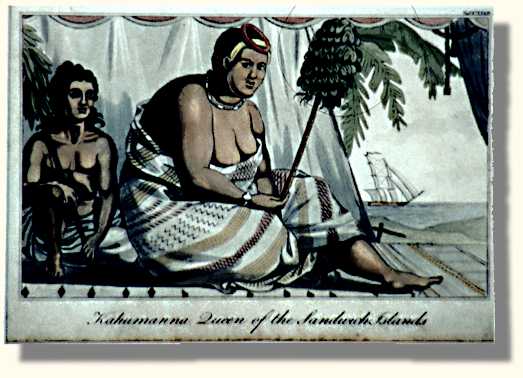 commoner women had left off by
convincing Liholiho to eat in public at a table of females shortly after his
father's death. The dramatic act was more than the violation of one taboo among
many. It signified the overthrow of the whole kapu system, and, with it,
the ancient religion. Upon completing his meal, Liholiho ordered the temples
destroyed and the images of the gods burned. So thorough was the conflagration
that only one hundred and fifty wooden sculptures escaped the flames. They have
survived to the present day thanks to the traditionalists who risked the king's
wrath by hiding them away.
commoner women had left off by
convincing Liholiho to eat in public at a table of females shortly after his
father's death. The dramatic act was more than the violation of one taboo among
many. It signified the overthrow of the whole kapu system, and, with it,
the ancient religion. Upon completing his meal, Liholiho ordered the temples
destroyed and the images of the gods burned. So thorough was the conflagration
that only one hundred and fifty wooden sculptures escaped the flames. They have
survived to the present day thanks to the traditionalists who risked the king's
wrath by hiding them away.
The Enlightenment was expressed in a unique fashion by this cultural
revolution. The oppressed gender demanded emancipation through the dismantlement
of an “irrational” religious prohibition. In so doing, they opposed the priests
who stood in the way of equality, a familiar Enlightenment motif. At the same
time, the process they initiated freed all Hawaiians from apparent moral and
intellectual subjugation by statues made with their own hands. Had he lived to
see the day, de Brosses would have been pleased to watch the islanders abandon
savagery by recognizing that no magical retribution would follow from the
destruction of their fetishes.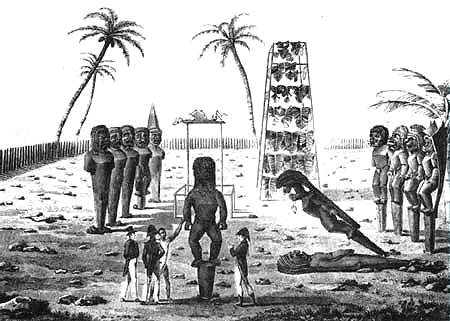 With this insight, they reached that threshold of scientific thought that Weber named
"disenchantment." What makes the whole event especially remarkable is that it was not a result of missionary activity. At least for a while, it did not
replace one spiritual framework with another, but an old time religion with no religion at all.
With this insight, they reached that threshold of scientific thought that Weber named
"disenchantment." What makes the whole event especially remarkable is that it was not a result of missionary activity. At least for a while, it did not
replace one spiritual framework with another, but an old time religion with no religion at all.
However, like nature, cultures abhor a vacuum. The triumph of the
Enlightenment in Hawaii was short lived. In 1820, Puritan missionaries arrived
from New England. As commercial interests robbed the Hawaiians of their land,
the missionaries consoled the people, not with reason's austere empire, but with
the promise of a heavenly home for the meek.
Voltaire; Zadig/L'Ingenu, John Butt, tr.
Penguine Books: Harmondsworth, Middlesex, 1964, 160.
Quoted in Discourse, 45-46.
Perhaps Voltaire sensed future historical events between
the words of the text. After all, the revolutionary mobilization of the sans
cullottes lay only four decades off.
Hume, p. 27. The passage is part of a long
unattributed excerpt from Hume's book that extends from 104 to 107 of Du
culte. The passage concerned is reproduced on page 106 of de Brosses'
book.
To be precise, two forms of naturalism are involved
here. The first consists in the rejection of transcendent principles of
explanation. The second identifies indigenous peoples with the condition of
animals. However, for the Enlightenment thinkers concerned, these two versions
of naturalism were never clearly distinguished.
Quoted in Valeri, Valerio. Kingship and
Sacrifice; Chicago: University of Chicago Press, 1985, p. 6
The Explorations of Captain James Cook in the
Pacific As Told By Selections Of His Own Journals, A. Grenfell Price, ed. Sydney: Angus and Robertson, 1969.
p. 259
There is a good account of this event in Kuykendall,
Ralph S. The Hawaiian Kingdom,
1778-1854: Foundation and Transformation;
Honolulu: The Univerity of Hawaii Press, 1957. Pp. 61-70.
 European expansion into
Africa and the Americas in the sixteenth century lies at the origins of global
capitalism. It also constitutes a radical break between the mediaeval and modern
periods. Before that break, the ruling classes of Europe acted in a world in
which their will to power was constrained by Islamic empires to be sure, but
also by the rudimentary state of navigation and cartography, and by a consequent
ignorance of global geography. After the break, they took their place at the
dominant center of an accumulation process that was destined to revolutionize
existing social conditions, both in Europe and beyond. An important aspect of such
revolutionary transformation was the elevation of science to an increasingly
significant position in maritime exploration, material production, and
intellectual life.
European expansion into
Africa and the Americas in the sixteenth century lies at the origins of global
capitalism. It also constitutes a radical break between the mediaeval and modern
periods. Before that break, the ruling classes of Europe acted in a world in
which their will to power was constrained by Islamic empires to be sure, but
also by the rudimentary state of navigation and cartography, and by a consequent
ignorance of global geography. After the break, they took their place at the
dominant center of an accumulation process that was destined to revolutionize
existing social conditions, both in Europe and beyond. An important aspect of such
revolutionary transformation was the elevation of science to an increasingly
significant position in maritime exploration, material production, and
intellectual life. lands and waterways in such a fashion that long
distance voyages could be undertaken and, even more importantly, repeated. This
methodical and precise information was a necessary condition of organizing the
exchange of commodities, and the extraction of economic surpluses, on a
planetary scale. Once the capitalist world market was in place, it acted as a
further incentive to scientific progress. Especially in the core countries,
consumer wants multiplied along with the means of satisfying them through
expanding circuits of commodity production and exchange. In response to the
growing demand for goods of all kinds, the wealthy began to reinvest their
profits in innovative industries and agricultural enterprises. These in turn
required the creation of a host of new natural sciences and stimulated the
development of already existing ones.
lands and waterways in such a fashion that long
distance voyages could be undertaken and, even more importantly, repeated. This
methodical and precise information was a necessary condition of organizing the
exchange of commodities, and the extraction of economic surpluses, on a
planetary scale. Once the capitalist world market was in place, it acted as a
further incentive to scientific progress. Especially in the core countries,
consumer wants multiplied along with the means of satisfying them through
expanding circuits of commodity production and exchange. In response to the
growing demand for goods of all kinds, the wealthy began to reinvest their
profits in innovative industries and agricultural enterprises. These in turn
required the creation of a host of new natural sciences and stimulated the
development of already existing ones. hegemony. The pretensions of Spain and Portugal to global
rule had collapsed in the early seventeenth century with the end of primitive
accumulation itself, that is to say, with the definitive consolidation of
capitalism as a self-sustaining mode of production and exchange. The rivalry
between the initial contestants gave way to a hundred year period of Dutch
domination. But that was only an interregnum. By the early eighteenth century,
the aspirations of the Low Countries had already been eclipsed by the ascendancy
of France and England, which now directed their national ambitions against one
another, sometimes in open warfare. Most of the Enlightenment thinkers of the
two contending powers were cosmopolitans, not nationalists. And many of them
argued vociferously against militarist adventures. But the wide public influence
they and their comrades enjoyed was not due to such pacific arguments. Rather,
it was a result of the fact that they offered broad and persuasive programs of
economic, political, and cultural reform to nations that saw themselves, quite
plausibly, as occupying the dynamic center of the planet. They promised to
replace the dogmatic anachronisms of Catholic Europe with sober insights into
the real forces capable of shaping a brave new world.
hegemony. The pretensions of Spain and Portugal to global
rule had collapsed in the early seventeenth century with the end of primitive
accumulation itself, that is to say, with the definitive consolidation of
capitalism as a self-sustaining mode of production and exchange. The rivalry
between the initial contestants gave way to a hundred year period of Dutch
domination. But that was only an interregnum. By the early eighteenth century,
the aspirations of the Low Countries had already been eclipsed by the ascendancy
of France and England, which now directed their national ambitions against one
another, sometimes in open warfare. Most of the Enlightenment thinkers of the
two contending powers were cosmopolitans, not nationalists. And many of them
argued vociferously against militarist adventures. But the wide public influence
they and their comrades enjoyed was not due to such pacific arguments. Rather,
it was a result of the fact that they offered broad and persuasive programs of
economic, political, and cultural reform to nations that saw themselves, quite
plausibly, as occupying the dynamic center of the planet. They promised to
replace the dogmatic anachronisms of Catholic Europe with sober insights into
the real forces capable of shaping a brave new world.
 In 1757, Charles de Brosses submitted the preliminary results of his
inquiry into the religiously significant material culture of indigenous peoples
to the Academie des Inscriptions et Belles-Lettres, of which he was a
member. At that point, Diderot became aware of the manuscript and suggested that
de Brosses communicate with Hume, whose Natural History of Religion had been
published earlier the same year. Brosses followed Diderot's suggestion, and
initiated a correspondence with the British philosopher, whose book and private
communications came to have a profound impact on his subsequent work. Under
Hume's influence, Brosses completed a treatise based on the material previously
submitted to the Academy and titled it, On the Cult of Divine Fetishes or the
Parallel between the Ancient Religion of Egypt and the Contemporary Religion of
the Negroes. Fearing persecution at the hands of the authorities, he
published the book in France in 1760 clandestinely, that is, through a third
party and without the author's name.
In 1757, Charles de Brosses submitted the preliminary results of his
inquiry into the religiously significant material culture of indigenous peoples
to the Academie des Inscriptions et Belles-Lettres, of which he was a
member. At that point, Diderot became aware of the manuscript and suggested that
de Brosses communicate with Hume, whose Natural History of Religion had been
published earlier the same year. Brosses followed Diderot's suggestion, and
initiated a correspondence with the British philosopher, whose book and private
communications came to have a profound impact on his subsequent work. Under
Hume's influence, Brosses completed a treatise based on the material previously
submitted to the Academy and titled it, On the Cult of Divine Fetishes or the
Parallel between the Ancient Religion of Egypt and the Contemporary Religion of
the Negroes. Fearing persecution at the hands of the authorities, he
published the book in France in 1760 clandestinely, that is, through a third
party and without the author's name.

 Diderot's decision to focus his account of “natural man” on the issue of
sexuality has an initial plausibility. Is sex not a matter of biological
processes that unfold, as it were, of their own accord, drives that demand
expression no matter what institutions attempt to block them? Here if anywhere
nature seems to prescribe a form of behavior that people oppose at their own
peril. Diderot's view that happiness results from the free expression of sexual
desire and misery from its repression found proponents in such twentieth century
radicals as Alexandra Kollontai, Wilhelm Reich, and Herbert Marcuse. But as
Foucault points out in his critique of such later versions of the discourse of
sexual liberation, the idea of a wholly natural sexuality is absurd. Whatever
role biological drives undoubtedly play in this central area of human
experience, they are always shaped by the institutions and symbolic systems
apart from which life in society is inconceivable. We can extend Foucault's
insight to the Supplement as well. What Diderot misinterprets as the
natural sexuality of Tahitians is simply an alternative expression of sexuality,
every bit as “artificial” as that of Europeans, but differently
configured.
Diderot's decision to focus his account of “natural man” on the issue of
sexuality has an initial plausibility. Is sex not a matter of biological
processes that unfold, as it were, of their own accord, drives that demand
expression no matter what institutions attempt to block them? Here if anywhere
nature seems to prescribe a form of behavior that people oppose at their own
peril. Diderot's view that happiness results from the free expression of sexual
desire and misery from its repression found proponents in such twentieth century
radicals as Alexandra Kollontai, Wilhelm Reich, and Herbert Marcuse. But as
Foucault points out in his critique of such later versions of the discourse of
sexual liberation, the idea of a wholly natural sexuality is absurd. Whatever
role biological drives undoubtedly play in this central area of human
experience, they are always shaped by the institutions and symbolic systems
apart from which life in society is inconceivable. We can extend Foucault's
insight to the Supplement as well. What Diderot misinterprets as the
natural sexuality of Tahitians is simply an alternative expression of sexuality,
every bit as “artificial” as that of Europeans, but differently
configured. an unfettered expression of the sexual drive, a refusal to be limited
by a supposedly arbitrary distinction between those who may and those who may
not be taken as partners. On the contrary, it was a device of the ruling class
for maintaining its genealogical claim to political power, and therefore
involved the regulated designation of an appropriate partner. Whatever the
natural component in sexuality may be, it has human significance only in
relation to the cultural order.
an unfettered expression of the sexual drive, a refusal to be limited
by a supposedly arbitrary distinction between those who may and those who may
not be taken as partners. On the contrary, it was a device of the ruling class
for maintaining its genealogical claim to political power, and therefore
involved the regulated designation of an appropriate partner. Whatever the
natural component in sexuality may be, it has human significance only in
relation to the cultural order.
 the ostensible goal of conducting an
experiment in astronomical observation. On June 3, 1769, the planet Venus was
due to make one of its infrequent transits across the disc of the sun. Some
astronomers believed that, if the time required for the transit could be
measured from two widely separated geographical points, then the distance of the
earth from the sun could be calculated. The Royal Society petitioned the British
Crown to fund a voyage to the Southern Hemisphere for the purpose of making one
of the two measurements. The Crown granted the request, purchased a collier for
the voyage, equipped it with the precision quadrant, telescopes, and chronometer
necessary to set up an observatory on Tahiti, and placed the forty year-old
veteran of the French and Indian War, James Cook, in command of the mission. But
it also provided Cook with secret instructions to continue his voyage beyond
Tahiti to see if he could discover the Southern Continent. While taking care not
to incite the natives, he was to claim whatever territory he could in the name
of the Crown. Cook failed to find the Continent and indeed eventually
demonstrated its apocryphal character. But he did manage to claim the eastern
coast of Australia as British territory, discover the Hawaiian Islands, and map
much of the South Pacific with a considerable degree of
accuracy.
the ostensible goal of conducting an
experiment in astronomical observation. On June 3, 1769, the planet Venus was
due to make one of its infrequent transits across the disc of the sun. Some
astronomers believed that, if the time required for the transit could be
measured from two widely separated geographical points, then the distance of the
earth from the sun could be calculated. The Royal Society petitioned the British
Crown to fund a voyage to the Southern Hemisphere for the purpose of making one
of the two measurements. The Crown granted the request, purchased a collier for
the voyage, equipped it with the precision quadrant, telescopes, and chronometer
necessary to set up an observatory on Tahiti, and placed the forty year-old
veteran of the French and Indian War, James Cook, in command of the mission. But
it also provided Cook with secret instructions to continue his voyage beyond
Tahiti to see if he could discover the Southern Continent. While taking care not
to incite the natives, he was to claim whatever territory he could in the name
of the Crown. Cook failed to find the Continent and indeed eventually
demonstrated its apocryphal character. But he did manage to claim the eastern
coast of Australia as British territory, discover the Hawaiian Islands, and map
much of the South Pacific with a considerable degree of
accuracy. The disparity between the explorers' sophisticated natural history and
their rough and ready attempts at ethnography is reflected in the corresponding
collections brought back to England. Several thousand natural history specimens
were collected under the direction of Banks, including plants, birds, fish,
insects, shells, and pieces of coral. They were classified approximately in the
field in accordance with the Systema Naturae, and were subsequently
assigned the appropriate Latin binomial nomenclature. By the time they were
exhibited in London, donated to wealthy patrons, or offered for sale, they had
already been more or less thoroughly exposed to the light of reason. Perhaps it
was because of this ability to introduce order into the chaotic profusion of
tropical organisms, and so to make sense of a part of the world that threatened
to escape European comprehension, that the natural history collections stirred
wider and more enthusiastic public interest than any other aspect of the
voyages.
The disparity between the explorers' sophisticated natural history and
their rough and ready attempts at ethnography is reflected in the corresponding
collections brought back to England. Several thousand natural history specimens
were collected under the direction of Banks, including plants, birds, fish,
insects, shells, and pieces of coral. They were classified approximately in the
field in accordance with the Systema Naturae, and were subsequently
assigned the appropriate Latin binomial nomenclature. By the time they were
exhibited in London, donated to wealthy patrons, or offered for sale, they had
already been more or less thoroughly exposed to the light of reason. Perhaps it
was because of this ability to introduce order into the chaotic profusion of
tropical organisms, and so to make sense of a part of the world that threatened
to escape European comprehension, that the natural history collections stirred
wider and more enthusiastic public interest than any other aspect of the
voyages.



 n its original sense, theosophy is a description of the dynamic
unfolding of the divine life as represented in the West by the work of mystics,
philosophers, and poets such as Jacob Boehme, Friedrich Schelling, and William
Blake. Only subsequently did it come to refer to a rather crude form of
nineteenth century occultism.
n its original sense, theosophy is a description of the dynamic
unfolding of the divine life as represented in the West by the work of mystics,
philosophers, and poets such as Jacob Boehme, Friedrich Schelling, and William
Blake. Only subsequently did it come to refer to a rather crude form of
nineteenth century occultism.

 by the southern rainstorms of winter,
marking the transition from the old to the new year. In Hawaii, the
revitalization of nature was associated with the return to earth of the god,
Lono, from his celestial home in kahiki. According to the myth, Lono once fell
in love with a beautiful mortal woman and married her after descending from the
sky by traveling along the arch of a rainbow. Though the two lived happily for a
while in Kealakekua, the god's jealousy soon brought disaster upon the couple.
Believing that his wife had been unfaithful with a human male, Lono beat her so
badly that she died, but not before she had time to convince him of her
innocence. Driven mad by grief and remorse, the god traveled throughout Hawaii,
boxing with the men he encountered along the way. When he had finally traversed
every district in the islands, he boarded a canoe which the people had filled
with provisions. As he departed, he promised to return one day bearing coconuts,
pigs, birds, and other foods. With a complicated series of rituals, the three
month Makahiki season marked the return of Lono and the fertilization of
his new bride, the land.
by the southern rainstorms of winter,
marking the transition from the old to the new year. In Hawaii, the
revitalization of nature was associated with the return to earth of the god,
Lono, from his celestial home in kahiki. According to the myth, Lono once fell
in love with a beautiful mortal woman and married her after descending from the
sky by traveling along the arch of a rainbow. Though the two lived happily for a
while in Kealakekua, the god's jealousy soon brought disaster upon the couple.
Believing that his wife had been unfaithful with a human male, Lono beat her so
badly that she died, but not before she had time to convince him of her
innocence. Driven mad by grief and remorse, the god traveled throughout Hawaii,
boxing with the men he encountered along the way. When he had finally traversed
every district in the islands, he boarded a canoe which the people had filled
with provisions. As he departed, he promised to return one day bearing coconuts,
pigs, birds, and other foods. With a complicated series of rituals, the three
month Makahiki season marked the return of Lono and the fertilization of
his new bride, the land. ships resembled the image of Lono that
was carried around the island during the Makahiki festival, repeating the
god's original circuit in the period of his madness. Each year the image made
its first appearance after a night of celebration that ended in an orgy meant,
no doubt, to evoke the generative powers of the god. When the people finished
making love to one another in the ocean's surf, they turned to behold the statue
of Lono standing higher up on the shore. The statue was in the form of an
akua loa, a “long god.” It consisted in a pole as much as seventeen feet
in length, the top of which was carved in the image of the deity. Though the
image may sometimes have consisted in a full anthropomorphic figure, the sole
surviving example of an akua loa depicts only the god's head, and this at
the comparatively minuscule length of two and a half inches. From a crosspiece
attached to the pole hung the skins of migratory birds, species that were
counted among Lono's “myriad bodies” since they returned with the southern
storms that revived the earth in winter. The skins were accompanied by feather
streamers and pieces of bark cloth. Not only did Cook's masts resemble the pole
and crosspiece of the statue, but his sails corresponded to the streamers and
bark cloth which, like them, sometimes billowed in the wind.
ships resembled the image of Lono that
was carried around the island during the Makahiki festival, repeating the
god's original circuit in the period of his madness. Each year the image made
its first appearance after a night of celebration that ended in an orgy meant,
no doubt, to evoke the generative powers of the god. When the people finished
making love to one another in the ocean's surf, they turned to behold the statue
of Lono standing higher up on the shore. The statue was in the form of an
akua loa, a “long god.” It consisted in a pole as much as seventeen feet
in length, the top of which was carved in the image of the deity. Though the
image may sometimes have consisted in a full anthropomorphic figure, the sole
surviving example of an akua loa depicts only the god's head, and this at
the comparatively minuscule length of two and a half inches. From a crosspiece
attached to the pole hung the skins of migratory birds, species that were
counted among Lono's “myriad bodies” since they returned with the southern
storms that revived the earth in winter. The skins were accompanied by feather
streamers and pieces of bark cloth. Not only did Cook's masts resemble the pole
and crosspiece of the statue, but his sails corresponded to the streamers and
bark cloth which, like them, sometimes billowed in the wind. ne surrounded by a wooden rail on which
were fixed the skulls of captives who had been sacrificed on the deaths of their
chiefs. The priests brought Cook through the entrance, where two wooden images
stood guard, and into the interior of the complex, where twelve more images were
arranged in a semicircle. Cook was draped in a red cloth similar to the one worn
by the central image, which he kissed in imitation of the head priest, Koah. He
was then led into another part of the complex, where he descended into a square
space sunken three feet into the ground. There he was seated between two
additional statues. As Koah held one of his arms and Lt. King supported the
other, Cook's body was made to assume the shape of the long god, the
Makahiki image of Lono.
ne surrounded by a wooden rail on which
were fixed the skulls of captives who had been sacrificed on the deaths of their
chiefs. The priests brought Cook through the entrance, where two wooden images
stood guard, and into the interior of the complex, where twelve more images were
arranged in a semicircle. Cook was draped in a red cloth similar to the one worn
by the central image, which he kissed in imitation of the head priest, Koah. He
was then led into another part of the complex, where he descended into a square
space sunken three feet into the ground. There he was seated between two
additional statues. As Koah held one of his arms and Lt. King supported the
other, Cook's body was made to assume the shape of the long god, the
Makahiki image of Lono.
 commoner women had left off by
convincing Liholiho to eat in public at a table of females shortly after his
father's death. The dramatic act was more than the violation of one taboo among
many. It signified the overthrow of the whole kapu system, and, with it,
the ancient religion. Upon completing his meal, Liholiho ordered the temples
destroyed and the images of the gods burned. So thorough was the conflagration
that only one hundred and fifty wooden sculptures escaped the flames. They have
survived to the present day thanks to the traditionalists who risked the king's
wrath by hiding them away.
commoner women had left off by
convincing Liholiho to eat in public at a table of females shortly after his
father's death. The dramatic act was more than the violation of one taboo among
many. It signified the overthrow of the whole kapu system, and, with it,
the ancient religion. Upon completing his meal, Liholiho ordered the temples
destroyed and the images of the gods burned. So thorough was the conflagration
that only one hundred and fifty wooden sculptures escaped the flames. They have
survived to the present day thanks to the traditionalists who risked the king's
wrath by hiding them away.